- Our Mission
- Our Partners
- Tea and Travel (In Books!)
- Arizona Towns
- Arizona Hiking Challenges
- Arizona National Parks
- Arizona State Parks
- Other Public Lands In Arizona
- The Dominican Republic
- Puerto Rico
- The Netherlands
- The United States
- New Zealand
- Itineraries


Visiting San Nicolas the Island of the Blue Dolphins
By waitingforrain28
On October 8, 2018
In Island Travel

Map of the island © Santa Barbara Botanic Garden
Visiting San Nicolas Island off of the coast of California is no easy feat. There’s really only one way, working for the Navy in some capacity. So, managing to get on a trip with Channel Islands Restoration , an organization that is contracted for environmental restoration on San Nicolas, was a huge opportunity. The following is my trip log for my journey out to the beautiful Island of the Blue Dolphins where I helped support CIR’s amazing work.
(Please note that NONE of the pictures in this post are mine. No photos of the island are allowed without permission from the Navy. Channel Island Restoration contractors are not allowed to bring cameras of any kind. If you would like to see more of San Nicolas, please look through William T. Reid’s photography over at his blog Stormbruiser.com . He has graciously allowed me to include a couple of his photos here.)
The Journey to San Nicolas

Anacapa and Santa Cruz (c) filippo_jean on Flickr (marked for reuse)
Luckily, on the morning that I was flying out to the island, I managed to find the right meeting place. I was immediately greeted by a wonderful group of people. I really have to say, if you are interested in volunteering for the environment of the Channel Islands, I can’t sing the praises of Channel Islands Restoration enough. They are an amazing organization and I am really happy that I managed to get myself out to their trip.
After meeting up with the group, we made our way to the gateway to the base. From there, we drove to the little one-room airport terminal. I had no idea what to expect once we were there, but checking in was little different than when I had flown on the little plane to Vieques. Checking the weight of you and your bags.
A Special Flight
What was more complicated was the plane schedule itself, or rather… getting back and forth, because thick fog and heavy winds are common on San Nicolas. The planes flying out there can’t really deal with either. So, our group ended up waiting several hours in the terminal, along with everyone else on our flight and the one before ours, which had yet to leave.
When we did climb onto the plane, I was delighted to get a single seat next to the window. There were far too many clouds for me to see any of the Channel Islands on the journey. But I was happy to watch the wavering layer of water vapor float by as we got nearer and nearer to this forbidden island. I honestly never thought I would be visiting San Nicolas Island.
Welcome to the Island of the Blue Dolphins

Channel Islands Fox from Wikipedia
As we landed, I got my first view of the desert island, and its characteristic flat mesa where little roads criss-crossed through the dry plant communities. Little buildings popped up here and there, boxy and defined by their utilitarian design. Once we landed, we pilled into a volunteer van and made our way to Nick Town. This is where all of the restaurants, barracks, and hotel rooms are. With a view of the ocean, I found this little Navy village to be inviting, if not vibrant and busy. I was also delighted to find out that the hotel there was extremely comfortable and even luxurious in comparison to many of the places that I stay.
Due to our delay at the airport, we took some time to hit up the little store in town. There I secured a gallon of drinking water and perused the sparsely stocked shelves for a souvenir. I settled on a wide, metal mug with the base logo on it.
Afterwards, we charged up for work by grabbing a cheap lunch at the cafeteria-esque Galley. Massive burritos were on offer and we all tucked in, enjoying the calories after our journey and hoping for it to carry us through the afternoon’s work.
Lending a Hand

Coreopsis gigantea | by John Game (labeled for reuse)
Once we had finished, the lot of us headed out into the field. Channel Islands Restoration carries out work on several of California’s Channel Islands. They raise and plant native plants for a variety of projects seeking to bring the islands closer to their natural state. Many of the Channel Islands were used as ranches in the past, which caused and necessitated major environmental changes.
On this trip, our work was to go through an older planting area to weed out non-native plants (plants that were brought to the islands by American settlers, in this case) and check on temporary irrigation lines. The extra water is meant to give the native plants a foot up as they establish and have to compete with young non-native plants. In the end, it was hoped that this work would a have a two-fold positive impact. (1) It would create a stripe of native plants, and (2) it would stabilize the soil, which is particularly important in the often windy environment San Nicolas.
Learning More About the Plant Community
Luckily for me, it wasn’t back breaking work and we moved relatively fast. I also had the opportunity to work with one of the senior volunteers, who had been out to San Nicolas with Channel Islands Restoration many times before. She was a wonderful teacher, who patiently taught me each of the native plants and their non-native nemeses (which she lovingly referred to as “the bad guys”).
When we had finished for that day, our illustrious and kind volunteer coordinator (seriously, this guy was amazing; I think his job must be so difficult and he wears so many hats- scientist, restorationist, volunteer coordinator/trainer, and tour guide) pilled us all into the van and took us out to see some of the sights.
I wasn’t expecting to get to do this while visiting San Nicolas Island, so needless to say, I was delighted.
Sightseeing on San Nicolas

Tranquility Beach (c) William T. Reid (Used with permission)
We took a road that cross the middle of the island and then curled around to the coast through forests of small trees called Giant Coreopsis. These eventually gave way to dunes and ice plants (non-native) as we came down from the central plateau of San Nicolas and moved towards the ocean. This area had previously been heavily impacted by ranching. At one point, there was hardly a plant left due to overgrazing. This caused the dunes to become wild, without any roots to slow them down.
Things are a bit better now. Without grazing pressure, plants (both native and non-native) have returned and stabilized many areas. Channel Islands Restoration and the Navy has been hard at work giving native plants a chance to come back. It has been a long journey and there is much further to go. But where ranch animals were dominating the landscape not too long ago, tiny Island Foxes now frolic in on an island which is slowly recovering its biodiversity.
San Nicolas is also a very important habitat for marine mammals such as elephant seals, sea lions, and even otters (it’s the only site in southern California that has a population of them after they were nearly hunted to extinction by fur traders). When they are out on the beach, people should keep their distance. These animals are very shy.
The Island Coast

Beautiful San Nicolas Island (c) William T. Reid (Used with permission)
Tranquility Beach, our first stop on our little tour, is a popular place for marine mammals. When we visited, however, it was deserted. So, under the watchful eye of our volunteer coordinator, we wandered out onto the sand. The air and sea were calm as we combed through shells we couldn’t take home, marveling at how beautiful they all were. The only sign that there had been elephant seals all over the beach in earlier weeks were the scraps of their shed fur that they had left behind.
Once we were done there, we continued driving around the island, where we passed through the driest area. I almost felt at home as we navigated down a road surrounded by cholla. We stopped at a loading pier where we stepped out to silently watch the sea lions far down on the beach. They didn’t notice us as we kept quiet, and two young pups frolicked with one another in the surf. It was a beautiful sight.
We topped the night off with a hearty dinner of burgers, salads, sandwiches and cookies at the restaurant in Nick Town. I can’t say how much I appreciated the soft, cozy bed of the hotel room when I finally returned for the night. No computer or phone to distract me from sleeping.
Locking the Keys in the Car

NOT something that we saw; elephant seals use San Nicolas at some times of the year and no one is allowed to disturb them. From Pixabay.
I took my breakfast in my room the next day, and met with the team for an early morning start on our project. Skilled from the day before, we worked quickly and before lunch we had finished up everything we needed to in the field. So we returned to the nursery where Channel Island Restoration raises the plants that they use for their projects on San Nicolas. We cleaned, and prepped tools for the next project before gathering our things to catch our flight off of the island in the mid-afternoon.
I had a minor heart attack when the keys got locked in our van, along with most people’s luggage. I was really afraid that we would miss our flight, as the small planes did not wait for late comers. Luckily, our volunteer coordinator and the island transportation head had us covered with the spare key. We made it on time to the airport.
But… ten minutes after everyone got checked in, it was announced that we wouldn’t be going anywhere that night. There had been an accident on the runway on the mainland, and the clean up would take some time. We had to settle in for a surprise extra night. Such are the risks one runs when visiting San Nicolas Island and other remote places like it.
Some Things Are Meant to Be

Rock Crusher from islandpedia.com
With my 7-8 hr drive home between me and home, whenever I could get a plane, plus work piling up, I found this a little distressing. But once again, our coordinator came to the rescue. He got us set up at the hotel again, and then took us out to one of the most special places on San Nicolas. Rock Crusher.
There we got to walk among the strange stone structures on the coast, and marvel at the endless break off the island in the ocean. We were all tired, and when we settled down to take in all of the beauty around us, a tiny otter surfaced in the kelp.
It seemed like a sign. Even though we were all stressed out, and weren’t planning to spend an extra night on the island, we were meant to be there. For me, it was a moment of pure beauty in which I found myself bathing in gratitude for the opportunity to be there, in that special, secluded place. I was grateful to have been given the chance to help Channel Island Restoration in their amazing mission, and lucky to have been with such an amazing group of people.
More Information on San Nicolas Island
For amazing photography of San Nicolas (and more) be sure to look through William T. Reid’s Stormbruiser blog!
If you’d like to donate your time or money to the effort to repair the environment of the Channel Islands, please visit Channel Islands Restoration to learn more about all the cool projects that they are working on.
We also have a guide to the Channel Islands chain if you’d like to know more.

Food Finds: Reathrey Sekong and Novel Ice Cream
The island of the blue dolphins: what’s the big deal about san nicolas island, 30 comments.
Add Comment →
What an incredible opportunity! I hope you get to go back and see an elephant seal one day!!
waitingforrain28
That would be great! But hopefully somewhere where I won’t disturb them.
Meghan Ramsey
What a beautiful island! It sounds like it was a little tricky to get to and has to be scheduled carefully but that it is worth it! Love how there is so much wildlife on this island!
Definitely difficult to get to, but worth it for sure. It was also great to have such a genuine opportunity to lend a helping hand.
Catherine’s Cultural Wednesdays
Love an island and now I have another to visit, thank you!
Islands are my absolute favorite, but this was the hardest to visit so far. It was definitely wonderful to give back while getting visit though.
Amazing journey and a very special experience (including the bonus night). I’m a little jealous and happy that you wrote about Nicolas Island.
Thank you! It is a very special experience to me, in particular because it was also very difficult. So glad I got to help the Channel Islands Restoration non-profit.
Wow that’s a great opportunity you got. Island looks incredible and Serene.
Thank you! It was amazing, and definitely serene even though it is being used by the Navy.
Brad Mongeau
San Nicolas island is my favorite place in the world! I’ve spent over a year anchored around that incredible island. I am an underwater and offshore photographer. As a civilian with no affiliation i was invited to island by the CO. It was a great honor and a day that i will never forget..I’ve been to that wreck and it is an awesome place..
Wow! That is amazing! I am so jealous. Hahaha. Honestly, getting to visit San Nicolas is one of my most treasured memories, so I can only imagine how cool it was to be invited by the CO. Have you been able to visit San Clemente?
EDWARD McCAFFERTY
was stationed there 1976-1978 with the navy explored every inch of island, left my name in a cave along with names from other explorers from the past some from the 1800,s ,love the abalone and lobster great place, read lady of the blue dolphins in J.H.S. when I was there there were feral cats and 2 ravens behind the navy galley, took a lot of pics.
Oh wow! Thank you so much for sharing. That must have been a very unique few years- San Nicolas is really a magical place. I bet your pictures are amazing!
San Clemente Island as well as San Nicholas Island have been absconded by the federal government, and I don’t like it. There is no reason for an early warning aircraft alert off shore in this day and age. Really, two of the best islands we have offshore. Can’t walk on them, fish unless given permission or camp out and enjoy the island solitude. Nope, this abduction is uncalled for and I as a citizen don’t like it. Maybe they can get the sea lions to wear a mask, but not this old goat.
Hey Michael, I honestly wish that these islands were also available and taken care of as public lands for many reasons. I wonder if we will ever see a time where this is the case. Otherwise, these beautiful places will be nearly impossible to see for most folks.
George bullen
As soon as they open up that Islands they’d be trash everywhere people would ruin it
Well, I doubt that will happen any time soon, if ever in our lifetimes. But the other islands are very well stewarded by the National Parks and TNC.
Rose Rutkowski
Thank you for this great article! I am visiting Santa Cruz Island next month and rereading Island of the Blue Dolphins in prep. Your article will help me be more mindful.
That’s amazing to hear, Rose! I hope you have a great trip!
Kenneth L BESCOE
Pulled my sea duty there, 18 months, loved it, lobster, sheep head were great and the diving was unreal.
Oh wow! I can’t even imagine. That is such a cool and unique experience.
Veronica D.
While watching the Hallmark channel they advertised a new Hallmark movie that’s airing tonight call “Navigating Christmas” and it’s about a snowstorm diverting a private plan to Christmas Island, and the name San Nicolas was mentioned. So, I Google searched the name; how awesome to know it’s a real place and from the pictures here, absolutely beautiful ❤️. Thank you for sharing. You were truly blessed to have this most memorable and exciting opportunity!!! 💖
I really was! I often feel grateful for having been able to visit such a beautiful and hard-to-reach place.
Thank you for your reply. Earlier I wrote about the Hallmark Channel featuring a show & mentioned San Nicholas; I was wrong. The correct location is St. Nicholas Island Lighthouse, two totally different places. Both beautiful and unique. Thank you for sharing your amazing experience with us. I’m grateful I found this site because I’ve learned something new and was able to see history and beauty in a remote place. You were truly blessed to have experienced something soòo amazing. Thank you again 💕 Happy Holidays 😊
San Nicolas is my favorite place in the world, i’ve spent over a year anchored around the island in my skiff since ’93. I have been doing offshore and underwater photography there for decades and i have a million pictures and stories. In 2016 the Commanding Officer of the island invited me for a visit. A Special Agent with the NCIS came to my house a few days prior, then had me to meet him at Pt Mugu. Lt,CDR Kemp met us at the terminal and took us to breakfast then dropped us off at Cissy Beach. He and i had a blast trekking to the pier before flying out that afternoon. That was a tremendous honor for this old sailor. I made a short video on youtube: https://www.youtube.com/watch?v=BjcLkWWhfMc&t=9s
Paul Coville
I served on San Nicolas Island in the late sixties I loved it.
Oh wow! That’s so cool!!
oh this place looks amazing!
It’s a very unique and special place for sure.
Leave a Reply Cancel reply
Notify me of follow-up comments by email.
Notify me of new posts by email.
Subscribe to Blog via Email
Enter your email address to subscribe to this blog and receive notifications of new posts by email.
Email Address
Follow me on Twitter
Nightborn Travel on Facebook
- Arizona Travel
- Backyard Discoveries
- Colorado Travel
- Cultural Highlight
- International Travel
- Island Travel
- Restaurants
- Tea & Travel
- The Un-Planner's Guide
- Tourism Science
- Travel Thoughts
- U.S. Travel
- Uncategorized
Explore freely. Tread lightly.
Powered by WordPress & Theme by Anders Norén
San Nicolas Island: The Gem Worth Discovering By You
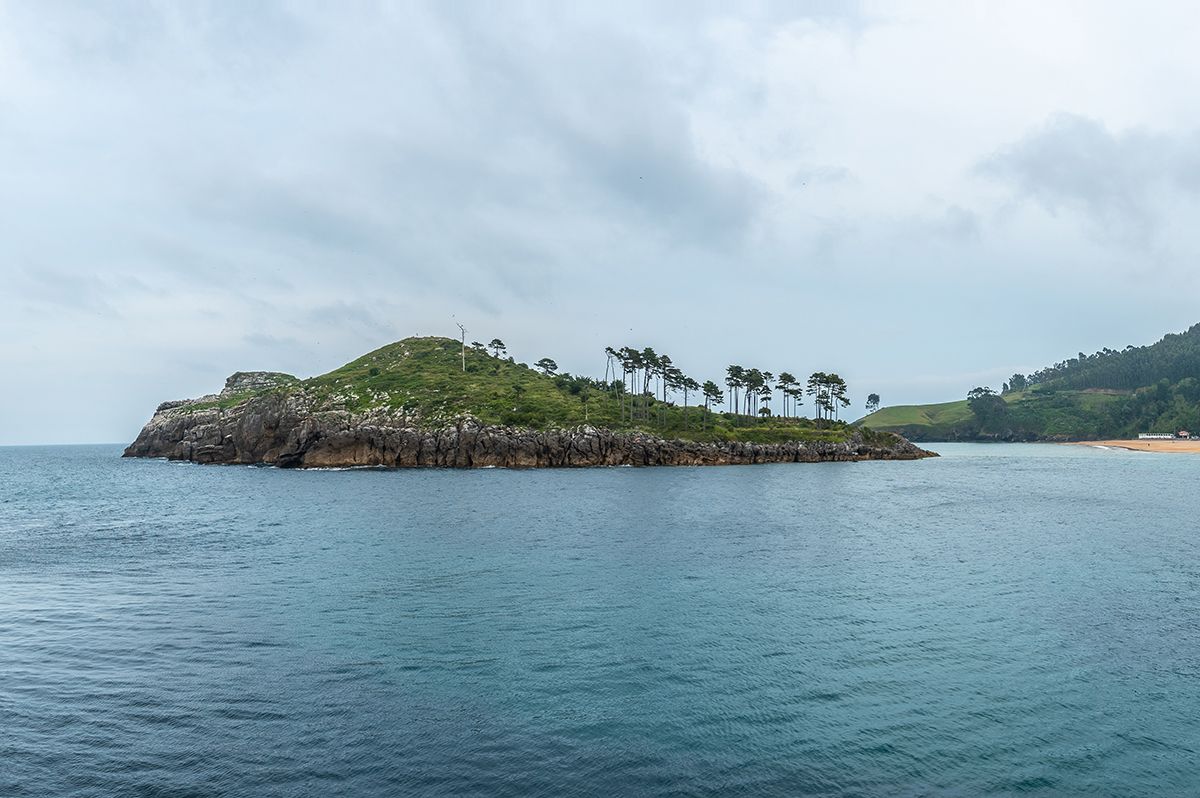
When we talk about secluded islands, we often take into mind some distant destinations like the Mariana Islands or Easter Island. But you can be surprised by the fact that secluded islands are not so far from you. For example, one of them belongs to California state! Haven’t you heard about San Nicolas Island? We’ll improve the situation and enclose that destination for you.
Location of San Nicolas Island: where is it?
Talking about California, we imagine luxury apartments, extensive nightlife, deluxe resorts, and lots of people surrounding us. But not every part of the state looks like that. For example, the Island of San Nicolas is still uninhabited yet it belongs to California.
Where is it located? San Nicolas Island is one of the Channel Islands located along the shores of California. Moreover, it is the most distant of them from the mainland. How far is San Nicolas Island from the California coast? The nearest point to the mainland lies 61 miles (app. 98 km) from it. Yet, it is still a part of the state, belonging to Californian Ventura County.
Some geographical facts about San Nicolas
If we talk about the geographical features of San Nicolas, then this is not the largest island in the area. How big is San Nicolas Island, you may ask? Total it is only 22.753 sq. miles ! There are no other significant landmasses nearby, but halfway to the mainland are the larger islands of Santa Catalina and San Clement, as well as the smaller but more famous Santa Barbara Island. By the way, despite belonging to Ventura County, San Nicholas Island is much closer geographically to the Los Angeles area.
San Nicolas Island’s population
As for other features of this location. This is actually an uninhabited island! San Nicolas Island’s population is unstable and depends only on current military exercises. The fact is that the island is under the jurisdiction of the United State Navy, and for more than a decade it has been used as a weapons testing and training ground, including for launching meteorological rockets and testing weapons. Most often, there are up to 200 military and civilians on the island, who live in several buildings built on San Nicolas. However, this island was far from always uninhabited, but we will talk about this a little later.
San Nicolas Island’s climate
As for the relief and climate, the maximum height of the island is only 203 meters, it actually consists entirely of flat plains with not the richest vegetation. But San Nicolas Island weather, although not as sultry as in Los Angeles, is quite mild. A pronounced steppe climate prevails here, with dry, hot summers and not-too-cold winters. Summer in the island conservation San Nicolas is dry, with an average temperature of +32 degrees. In winter, there are no more than 30 rainy days, and the temperature usually does not fall below +12. But despite such favourable climatic conditions, the island of San Nicolas attracts tourists. This is due to the strict rules of the military, in whose department the island is located.
Do Not Mistake: There Are Several Other Islands With the Similar Name
There are one big mistake backpackers may make when they try their chances to get to San Nicolas Island. As it is quite common in geographical naming, this name belongs to several more destinations. For instance, you can spell it differently. You shouldn’t mistake Californian San Nicolas Island for the following places that sound similar:
- San Nicolas is the name of the district in Buenos Aires (Hispanic Barrio de San Nicolas).
- San Nicholas is the resort on Aruba Island and its fourth biggest city that provides beach vacation services.
So, there are sometimes, several mistakes with this.
Some historical facts about San Nicolas and lone woman story
Besides its remote secluded location and quite a special US Military status, San Nicolas can also boast of its tremendous history.
Nicoleno people
First of all, the island was the cradle of the Native American tribe Nicoleno people . They are also connected with the Tongva tribe that lived on the nearby island of Santa Catalina. Until the European conquerors arrived on the island of San Nicolas, the locals were able to develop their own tribal civilization here, as well as a unique language and culture.
Moreover, historians have proven that the first inhabitants of San Nicolas appeared as much as 10,000 years ago, which is quite a lot for the islands. But in 1602, everything went wrong when Spanish colonists led by Sebastian Vizcaino showed up on the island. He quickly came up with a name for the island, San Nicholas, in honour of the Christian saint, the patron of sailors. This choice of name was not accidental because the conquistador noticed the island just on the eve of the memory of the saint, December 6th.
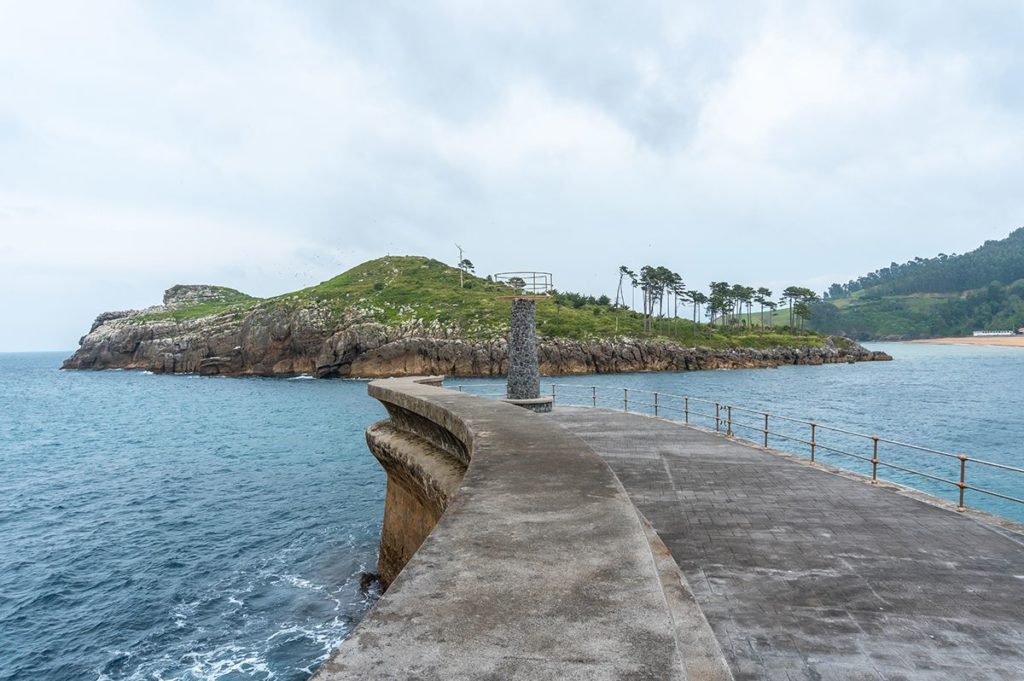
Massacre on San Nicolas island
Be that as it may, for another 200 years, the authentic population of the island retained its culture and tribal way of life, until in 1811 a catastrophe occurred, which was called the Massacre when the remnants of the most remote the population were destroyed by trappers. Those who survived were able to evacuate the island thanks to the Californian missionaries. The remnants of the Nicoleno tribe gradually assimilated with the inhabitants of the mainland, and their language finally disappeared after 1853. When Juana Maria, a hermit who lived in seclusion on San Nicolás for more than 18 years without contact with the outside world, was taken from the island.
The lone woman of the San Nicolas Island case has become unique in its own way. Her tribe has inhabited the small island of San Nicolas for centuries. At the time of the dramatic events, there were about three hundred people.
Extermination of the Indigenous population
In 1814, the Russian brig Ilmena moored to the island. The team of fur hunters consisted of Russians and Indians of the local tribe of the Aleuts, with whom they had skirmishes at different times. The reason for the collision was the accusation of a local resident of the death of a member of the ship’s crew. The newcomers exterminated the indigenous population almost completely, only a couple of dozen people escaped.
When a ship from the Santa Barbara Catholic Mission arrived at San Nicolas in 1835, only a few women and an old man named Black Hawk were left alive. The last of the Nicoleños were transported to the mainland, but Juana Maria was not among them. There is a version that she was in the boat that brought the natives to the ship, but at the last moment, she threw herself into the water, her little son or brother was not in the boat. The team did not linger, a strong storm was approaching, and the lone woman of San can be left alone on the island.
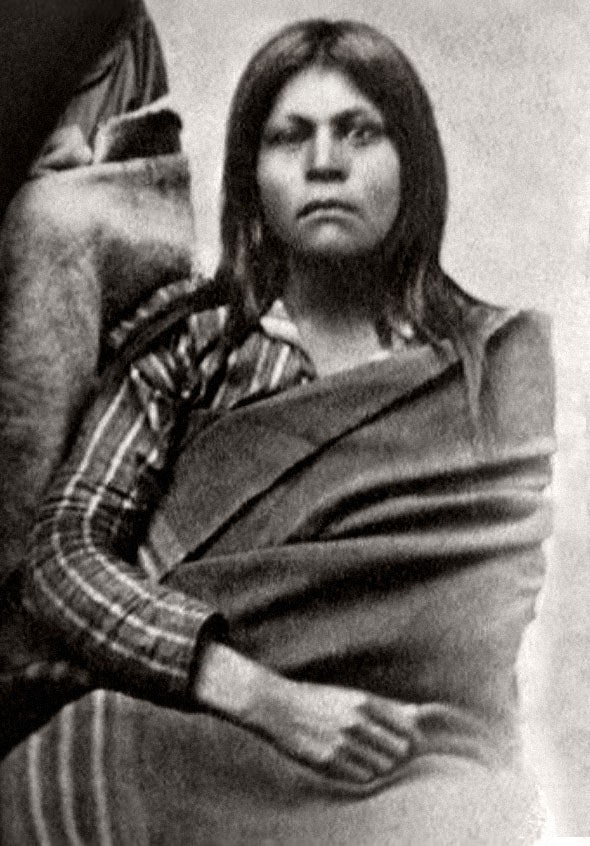
The lone woman Juana Maria
Juana Maria and her supposed son were the last of the San Nicolas natives, as the rest of the tribe was decimated by an infection to which the natives had no immunity. Two more unsuccessful attempts were made to take the woman and child out. But they skillfully avoided contact with the sailors, birds and those, having wandered around the island, returned sloppy slurping. Only the third attempt was successful.
Hunter and tracker George Nidever discovered the woman in November 1853. She looked full of energy, smiling and friendly, there was no one else on the island. Sailors found her whalebone hut and shelter in caves. The woman learned to get her own food, her menu included poultry, shellfish and even seals. When she was taken to Santa Barbara, it turned out that the local Indians did not understand her. The woman could not even give her name, so she was christened Juana Maria. She was cheerful, and willingly sang and danced traditional dances for her people. She was delighted with children at the sight of many things familiar to others, especially horses conquered her. Unfortunately, she lived only seven weeks in the civilized world, just like her fellow tribesmen, she fell victim to dysentery.
How to Get to San Nicolas Island
If you are interested in if can you visit San Nicolas Island, then there is no definite answer to this question yet. On the one hand, the island remains under the jurisdiction of the US military, but at the same time, you can get here by charter flights in agreement with the military leadership. The island has its own small airport, so if you don’t know how to get to San Nicolas Island, flying is ideal.
San Nicolas Island is a destination that is well worth the effort to visit. Whether you’re a nature lover, a history buff, or just looking for a unique and off-the-beaten-path destination, San Nicolas Island is a gem that is waiting to be discovered.
Read also: Private Island to Rent in Belize: Tips and Offers
Related Articles
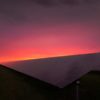
Transforming Tau Island: A Solar-Powered Paradigm Shift Towards Sustainable Energy
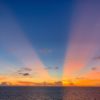
Western Caribbean Islands at a Glance: Top 3 Destinations to Schedule

Mexico Islands: Top 10 Destinations for Wonders’ Seekers and Tourists

Disney Castaway Cay Unveiled: A Complete Guide to the Ultimate Fantasy Cruise Destination
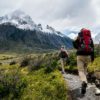
Hike 10 Breathtaking Islands: Mountains, Beaches & More
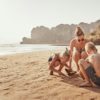
10 Best Family Vacation Islands: Plan Your Dream Getaway
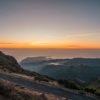
Madeira Island: Your Unforgettable Island Escape Awaits in 2024
- Best islands for vacation
- Central America
- Islands rental
- North America
- Private Island Development
- Private Islands Prices
- South America
Enter your name & email address to follow this blog and receive notifications of new posts.
- Skip to global NPS navigation
- Skip to the main content
- Skip to the footer section

Exiting nps.gov
Explore the islands.
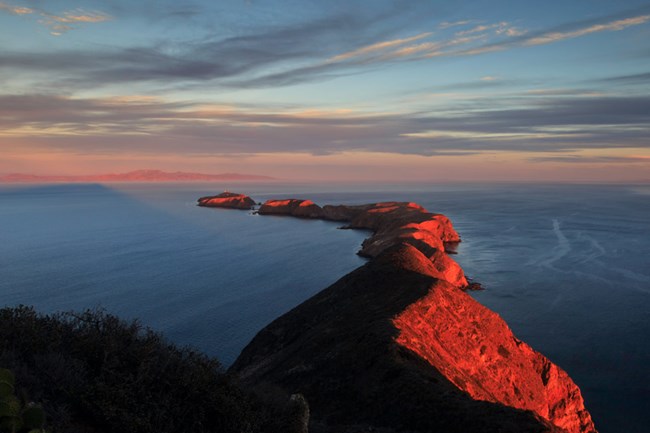
Though Karana's home on San Nicolas Island is a creation of Island of the Blue Dolphins author Scott O'Dell, many of the animals, plants, people, and places are based on the actual Channel Islands, which you can explore and learn more about on this website.
Once you've journeyed through this web resource's features, you can visit the Channel Islands National Park website . Plan your visit to one of the park's five islands to see island plants, animals, and environments for yourself!
Learn about all eight of the Channel Islands.
Learn about fascinating island environments and their inhabitants.
Explore Karana's world as well as the present-day San Nicolas through interactive maps.
Last updated: November 8, 2018
San Nicolas Island: A Hidden Gem and Wildlife Paradise
- by Richard Edwards
- November 3, 2023
Welcome to our blog post all about San Nicolas Island! If you’re curious about this lesser-known gem nestled along the California coast, you’ve come to the right place. San Nicolas Island, one of the Channel Islands, boasts stunning landscapes, diverse wildlife, and a fascinating history that is waiting to be explored.
In this comprehensive guide, we will answer your burning questions about San Nicolas Island. From its population and accessibility to its unique features and activities, we’ll provide all the information you need to satisfy your curiosity. So, sit back, relax, and get ready to embark on a virtual journey to this captivating island destination.
But first, let’s dive into some intriguing facts about San Nicolas Island to pique your interest.

What is the population of San Nicolas Island
San Nicolas Island, nicknamed “The Hidden Gem of Southern California,” boasts not only stunning natural beauty but also an intriguing history. Tucked away off the coast of California, this small island is home to a unique community that has captured the curiosity of many. So, what’s the population like on this marvelous piece of land?
Population: A Secret Revealed
Despite its idyllic charm and undeniable allure, San Nicolas Island has a surprisingly modest population. As of the latest census in 2023, the island is home to approximately XXXX residents. However, don’t be fooled by the island’s small size – it’s the people that truly make it special.
The Santa Cruz Connection
San Nicolas Island may be best known for its association with the legendary character, the “Lone Woman of San Nicolas Island.” Made famous by Scott O’Dell’s novel, “Island of the Blue Dolphins,” the Lone Woman was a Native American woman who lived alone on the island for several years in the early 19th century. Her story has captivated the hearts of many, and today, her legacy continues to be celebrated.
Military Presence and Research Facilities
Apart from its unique history, San Nicolas Island is also home to the United States Navy’s San Nicolas Island Naval Facility. The military has had a presence on the island since World War II, and the base serves as an important research and testing site for various military operations. The island’s population includes military personnel, researchers, and support staff who contribute to its vibrant community.
A Whimsical Blend
The residents of San Nicolas Island represent a diverse blend of individuals from different backgrounds and professions. From military personnel to scientists, researchers to support staff, and even a handful of lucky civilians who get to call this paradise their home, the island’s population paints a unique picture of community and camaraderie.
A Surfer’s Paradise
San Nicolas Island is renowned for its fantastic surfing conditions, attracting wave enthusiasts from far and wide. Surfers, both local and visiting, add a vibrant touch to the island’s population during the peak surfing season. Catching the perfect wave and enjoying the island’s natural beauty become integral parts of their daily routines.
Wildlife Wonders
While humans play an essential role in San Nicolas Island’s population, we mustn’t forget about the incredible wildlife that calls this place home. The island’s coastal and marine ecosystems are teeming with diverse species, including sea lions, seals, dolphins, and a variety of seabirds. This harmonious coexistence between humans and nature creates a truly magical atmosphere for all who visit.
San Nicolas Island may have a small population, but it undoubtedly packs a punch when it comes to natural beauty, history, and community spirit. From its intriguing association with the Lone Woman to its military and research facilities, the island boasts a fascinating blend of residents. Whether you’re a surfer chasing the perfect wave or a nature lover seeking tranquility, the island welcomes you to discover its hidden treasures. So, why not embark on an adventure to San Nicolas Island and become a part of its vibrant tapestry?
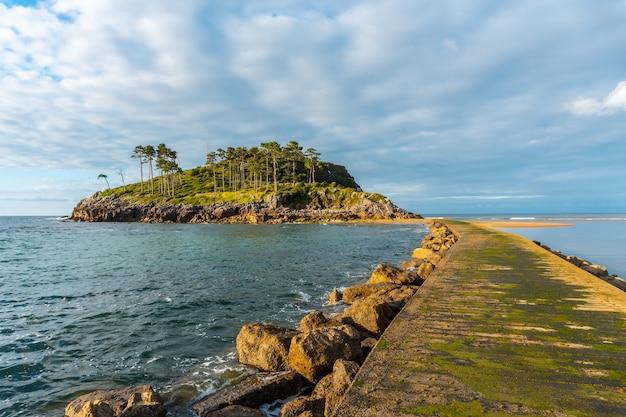
FAQ: Discovering San Nicolas Island
If you’re curious about San Nicolas Island and eager to uncover its enchanting mysteries, you’ve come to the right place. From its population to its aquatic wonders, we have compiled a comprehensive list of frequently asked questions to satisfy your curiosity. So, sit back, relax, and let’s embark on a virtual journey to San Nicolas Island.
1. Can civilians visit San Nicolas Island
Now, wouldn’t that be exciting? However, San Nicolas Island, with its intangible allure, remains off-limits to civilians. It serves as an essential military installation, ensuring that only authorized personnel can experience the island’s hidden treasures.
2. How far is San Nicolas Island from the California coast
As you daydream about setting foot on this captivating island, you may wonder about its distance from the California coast. San Nicolas Island lies approximately 61 miles off the coast, teasing adventurers from afar with its captivating beauty.
3. What is San Nicolas Island used for
Ah, the secrets of San Nicolas Island! Primarily, it serves as a crucial training ground for the United States military. With its strategic location and abundant natural resources, the island plays a significant role in honing the skills and expertise of our brave troops.
4. Are there snakes on the Channel Islands
Fear not, intrepid explorers! While snakes may instill a sense of trepidation in many, these slithering creatures have chosen to steer clear of the Channel Islands, including San Nicolas Island. So, put your mind at ease and embrace the island’s reptile-free wonders.
5. What is special about Catalina Island
Ah, you’ve shifted your focus to another captivating location—the charming Catalina Island! Catalina Island, also part of the Channel Islands, boasts an enchanting blend of natural beauty, captivating wildlife, and exciting recreational activities. It’s a treat for your senses and a slice of paradise you won’t want to miss.
6. Which country is San Nicolas Island in
San Nicolas Island, although rich with captivating allure, belongs to the vibrant United States of America. It takes its place amongst the delightful Channel Islands off the beautiful California coast.
7. Who owns the Catalina Islands
Let’s delve into the ownership of the beloved Catalina Islands—these stunning gems are proudly owned by the Santa Catalina Island Company. With their dedication and stewardship, they ensure that visitors can savor every ounce of beauty and adventure these islands have to offer.
8. Is there fresh water on San Nicolas Island
A glimmer of hope for those longing to quench their thirst in the island’s embrace—yes, San Nicolas Island does have freshwater resources. This precious liquid sustains the delicate balance of life and offers a refreshing oasis amidst the glistening Pacific Ocean.
9. Can you see San Nicolas Island from the mainland
Oh, if only it were that easy! Alas, San Nicolas Island does not reveal its captivating presence from the mainland. This hidden treasure remains concealed in the shimmering waters, awaiting those lucky enough to set foot upon its shores.
10. What animals live on San Nicolas Island
Prepare to encounter a diverse array of wildlife residing on this secluded paradise. San Nicolas Island is home to an abundance of fascinating creatures, including sea lions, seals, dolphins, pelicans, and a variety of seabirds. So, keep your eyes peeled for these delightful inhabitants during your visit.
11. What is on San Nicolas Island now
The island, steeped in history, currently serves as an essential military installation. However, beyond its strategic significance, it remains a sanctuary for breathtaking coastal landscapes, fascinating wildlife, and the echoes of ancient stories waiting to be unraveled.
12. Does anybody live on San Nicolas Island
Although the island welcomes military personnel to its shores, it remains uninhabited by permanent civilian residents. San Nicolas Island stands as a testament to the awe-inspiring power of nature, captivating the hearts of all who lay eyes upon its untouched beauty.
13. Where is the girl from Island of the Blue Dolphins buried
Lifted from the pages of history, the girl from the beloved novel “Island of the Blue Dolphins” rests in peace on this very island. San Nicolas Island cradles the final resting place of this courageous young woman, its silent beauty honoring her fierce spirit and captivating tale.
14. Can you live on Santa Rosa Island
While Santa Rosa Island may tempt us with its serene charm, it remains a predominantly protected space without permanent civilian residents. As a part of Channel Islands National Park, it offers a sanctuary for nature’s beauty to thrive undisturbed.
15. Does anyone live on San Clemente Island
Just a glimpse of San Clemente Island’s alluring features would make anyone want to call it home. However, similar to Santa Rosa Island, San Clemente Island is primarily a military installation and remains devoid of permanent civilian residents.
16. How do you get to San Nicolas Island
Ah, the path to this island paradise! Access to San Nicolas Island is exclusively reserved for authorized personnel. As a military installation, it invites only those fortunate enough to have the opportunity to experience its natural wonders firsthand.
17. Are there still wild dogs on San Nicolas Island
While San Nicolas Island may harbor a rich diversity of wildlife, including enchanting marine creatures and captivating avian species, it is blissfully free from the presence of wild dogs. So, you can explore the island’s captivating landscapes without any fears of canine encounters.
18. Can you fish on Santa Barbara Island
Determined anglers hoping to uncover hidden fishing spots may have to look elsewhere, as fishing on Santa Barbara Island is not permitted. Instead, embrace the island’s other wonders, from its stunning coastal views to the captivating marine life.
19. Does anyone live on Santa Cruz Island
Santa Cruz Island, with its rugged beauty and awe-inspiring landscapes, beckons nature enthusiasts and adventure seekers alike. While some parts of the island are privately owned, it is primarily under the stewardship of the National Park Service. Thus, Santa Cruz Island remains predominantly uninhabited.
20. Can you fish on San Nicolas Island
Calling all anglers! San Nicolas Island invites you to cast your line and engage in a thrilling fishing experience. Explore the marine world and try your luck in the bountiful waters around the island while relishing nature’s serenade.
21. How many miles long is San Nicolas Island
Oh, the vastness of this enchanting island! San Nicolas Island stretches approximately 22 miles long, reminding us of the boundless wonders hidden within its shores. Prepare yourself for an adventure that spans the length and breadth of this captivating coastal gem.
22. What does the Navy do on San Clemente Island
Now, this is where things get intriguing! San Clemente Island hums with the buzz of naval operations. As a United States Navy training range, it plays a vital role in preparing our military forces for the challenges that lie ahead. From specialized training exercises to exciting maritime operations, the island breathes life into the strength and resilience of our armed forces.
So there you have it—answers to some of the burning questions about San Nicolas Island. From its enigmatic allure to its diverse wildlife, we hope this FAQ section has shed light on the island’s captivating secrets and left you yearning for a chance to experience its breathtaking beauty firsthand. Until then, let your imagination soar and let the island’s essence whisk you away on an unforgettable adventure!
- blue dolphins
- california coast
- catalina island
- channel islands
- diverse wildlife
- fascinating history
- military personnel
- research facilities
- san nicolas island
- santa cruz connection
- stunning natural beauty
- undeniable allure
- unique community
Richard Edwards
Tony and ziva: a love story unraveled on ncis, who is pervy sage exploring the enigma behind jiraiya's real name, you may also like, understanding teasing: what it means to a guy.
- by Brandon Thompson
- October 21, 2023
What is the Blue and Brown Wire?: Decoding Wire Color Codes
- by Donna Gonzalez
- October 13, 2023
Can You Use Vaseline After Lip Blush?
- by Willie Wilson
- October 18, 2023
Is GREY Goose Made in Russia?
- by Mr. Gilbert Preston
Discover the ENFP Disney Princesses: Unveiling the Magic of Personality Types in the Kingdom of Dreams
- by Brian Thomas
- October 29, 2023
Is There an Alternative to Branding Cattle?
- by Laura Rodriguez
- October 10, 2023
- Skip to global NPS navigation
- Skip to this park navigation
- Skip to the main content
- Skip to this park information section
- Skip to the footer section

Exiting nps.gov
Alerts in effect, return to the island of the blue dolphins.
Last updated: November 16, 2016
Park footer
Contact info, mailing address:.
1800 Cabrillo Memorial Drive San Diego, CA 92106
619 523-4285
Stay Connected

- Hours & Reservations
- Plan Your Visit
- Classes & Events
- Youth Programs
- Accessibility
- Private Rentals & Photography
- Collections
- The Power of Native Plants
- Native Plant Gardening Tips
- Grow Native Plants
- Landscaper Certificate Program
- More Ways to Give
- Tribute & Memorial Gifts
- Sponsorships
- Our Approach
- Our Honorees
- Community Conservation
- Our Mission
- Financials & Media
Biodiversity Conservation on San Nicolas Island
As the most remote of the California Channel Islands, San Nicolas has the reputation of being a mysterious, wind-swept place. Known popularly as the Island of the Blue Dolphins from the 1960 Scott O’Dell novel, this place served as the setting for the tale, which was inspired by the real-life events of the Lone Woman. She was the last of the original human inhabitants who called San Nicolas home for thousands of years. The original residents were massacred by sea otter hunters in 1811, and the remaining people were removed from the island in 1835. The only exception was the Lone Woman who remained on the island for 18 years. Beginning in 1853, San Nicolas was used by a series of sheep ranchers before final transfer of the land to the U.S. Navy in 1947, when it became part of the Naval Air Station at Point Mugu. There are few records of what the vegetation looked like prior to the ranching period, during which native shrubs were nearly eliminated due to grazing and lichen crusts were severely damaged due to trampling.

In 2019, we partnered with the Naval Base Ventura County, San Nicolas Island natural resources managers to document the biodiversity of the island, especially focused on historically under-collected groups like lichens and fungi. Using what we learned, we are applying genetic tools to increase ecological knowledge of the charismatic endemic foxes and snails. We are doing this in three parts: 1) Documenting biodiversity through surveys and collection of specimens that are placed in natural history museums, 2) Building a DNA reference library using tissues associated with these museum specimens, 3) Diet analysis of the San Nicolas Island fox (Urocyon littoralis dickeryi) and San Nicolas Island snail (Micrarionta feralis).
This project began with assembling a team of biodiversity specialists. The group’s goal was to make a new suite of natural history collections along with tissue samples for concurrent genetics work. The team of taxonomists included the Garden’s Tucker Plant Systematist and Herbarium Curator Dr. C. Matt Guilliams and Conservation Geneticist Dr. Kristen Hasenstab-Lehman for vascular plants, Dr. Benjamin Carter, Assistant Professor at San Jose State University for mosses and liverworts, the Garden’s Tucker Lichenologist Dr. Rikke Reese Naesborg for lichens, Christian Schwarz, Research Associate at University of Santa Cruz for macrofungi, and the Garden’s Conservation Technician Stephanie Calloway and Invertebrate Biodiversity Postdoctoral Scholar Dr. Casey Richart for terrestrial invertebrates. Once assembled, the team headed out for several surveys throughout the year and made many discoveries along the way. Our surveys resulted in:
• 405 new vascular plant specimens, eight of which are new records for the island
• 80 bryophytes, adding eight new species and one new family of liverworts for San Nicolas
• 610 collections of lichens, 48 of which were new island records; one is new to science
• 113 macrofungi collections, representing the first ever collected on San Nicolas; two collections are new species to science
• Over 340 collections of over 100 species of invertebrates, including what appears to be a new millipede to science

During the second phase of this project we are constructing a DNA reference library for San Nicolas Island that consists of barcode markers from the tissues collected during surveys. These are small portions of the genome unique for different types of plants, fungi, and animals. Reference libraries, backed up with the museum specimen and expert determination of that collection, can be used as a carefully curated database to search against when trying to identify species using DNA. In the Santa Barbara Botanic Garden’s genetics lab, we are taking samples provided by collectors, isolating DNA, and sequencing barcode markers. We place both the barcode markers and associated specimen information in online platforms so that it can be used as a resource, both in our studies as well as by researchers from across the globe.

In the third part of this study we are using DNA barcodes to increase the understanding of diet of both San Nicolas Island Foxes and Island snails. Previous studies have used physical assessment of scat to understand and assess food sources of Island foxes. However, these methods usually cannot detect soft-bodied organisms such as terrestrial invertebrates, fungi, lichens, and green plants. All of these groups could be resources in an omnivore diet, but we don’t know which species might be important in supporting a healthy population of foxes on San Nicolas. DNA sequences found in their scat can be compared against the DNA reference library to know which potential food items are important in this intricate food web. This same method can be applied to the extremely rare San Nicolas Island snail, for which physical examination of the scat leaves more questions than answers. This snail is thought to be an herbivore, but whether it is eating green plants, lichens, or fungi is unknown. Additional threats for these snails include carnivorous land snails, introduced to the island in the twentieth century. Assessing whether the endangered snails are a component of the predatory snail’s diet will allow Navy biologists to take conservation action if needed to reduce the chance of extinction of an island endemic.


We are using traditional, boots on the ground biodiversity inventories to increase our understanding of organisms on San Nicolas Island, which has resulted in 1,468 museum collections, 181 organisms documented for the first time on the island, as well as the discovery of four species not known to science.

The Santa Barbara Botanic Garden and its partners on this project are using modern approaches to build a reference library that will serve as the basis for species identification using DNA in samples, such as scat, that are not readily determined in other ways. This knowledge will aid land managers from the Navy in understanding ecosystem level interactions that support survival for all branches of the tree of life on San Nicolas, and will help land managers make science-based natural resource decisions for species from the well-known island fox, to the lesser known but equally interesting San Nicolas Island snail. This blending of traditional and cutting-edge collaborative biodiversity research is what allows the Garden to be a leader in California conservation and research.

Adventures in Research
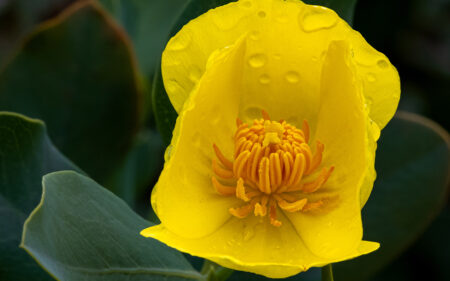
Nature Educators Provide Transformative Experiences
La colina junior high: a mission to add native plants .
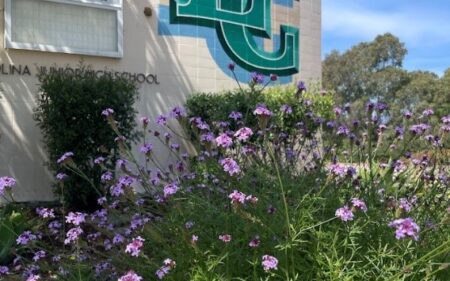
Dudleya | Celebrating California’s Star Succulent
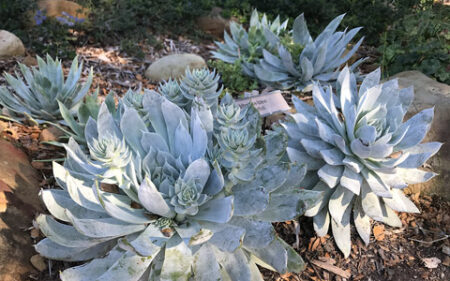
Wings and Wildflowers: New Art Exhibit is an Homage to Habitat

Future-Proofing Food Webs: A Bold Habitat Restoration Experiment at Elings Park
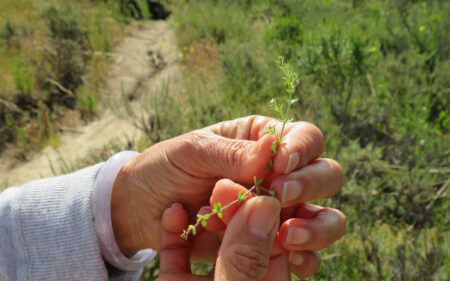

Why colourful San Nicolas should be on your Aruba itinerary
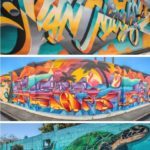
With a thriving arts scene, laid-back vibe and prime location near breathtaking beaches, the colourful town of San Nicolas is one of the best places to visit in Aruba to get a dose of culture.
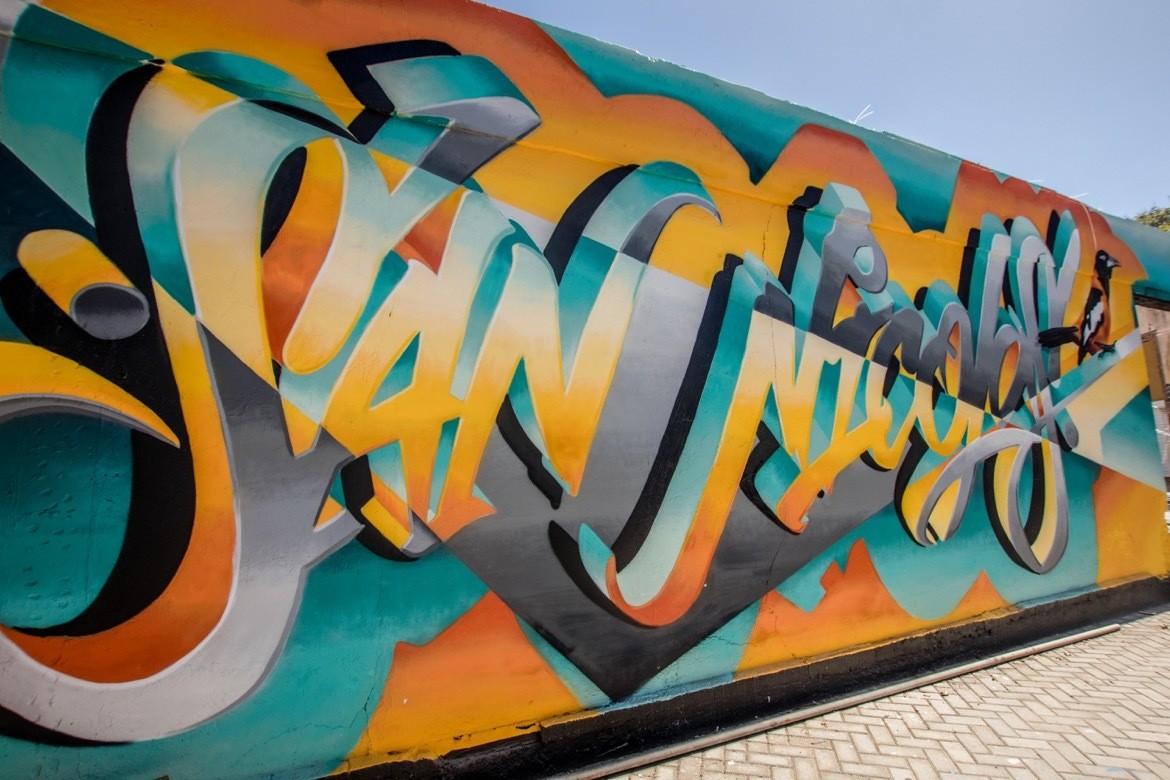
Far removed from the glitz, glam and commercialization of tourist areas like Palm Beach and the capital Oranjestad, the so-called ‘Sunrise City’ is a creative hub best known for the larger-than-life murals blanketing its downtown area.
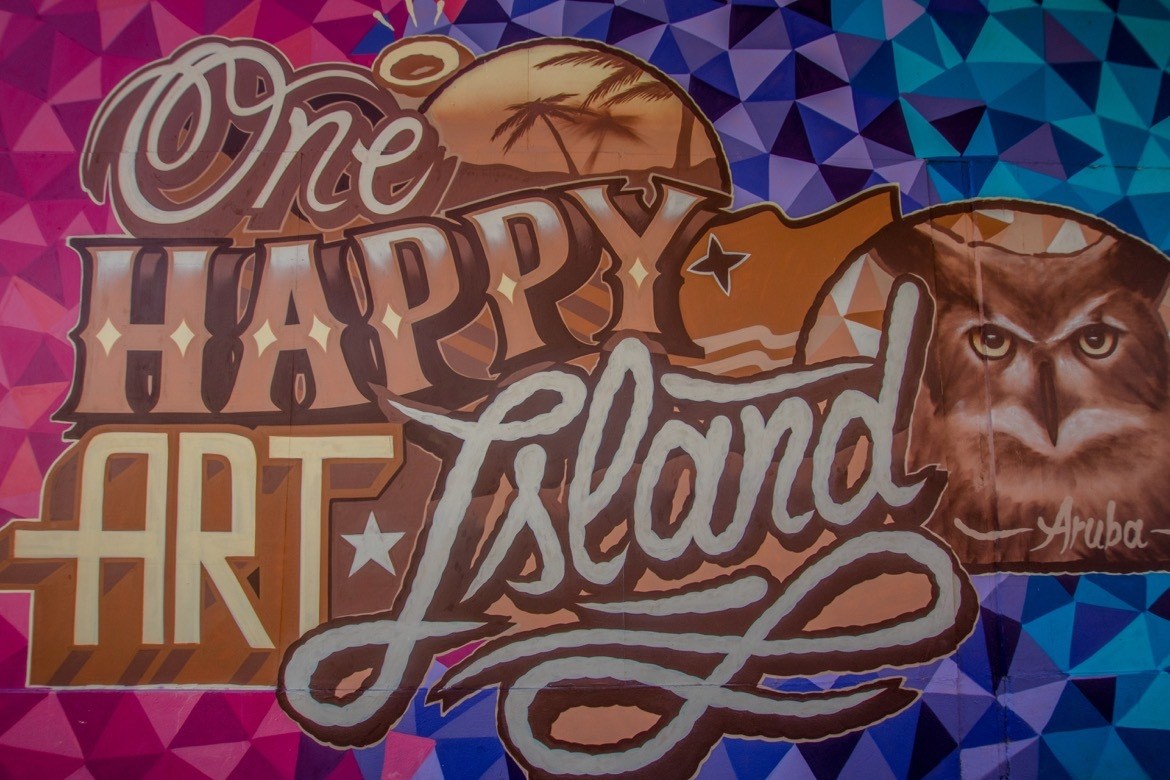
Originally a bustling industrial centre due to its oil refinery, Aruba’s second-largest city has a long history of calypso music, steel drum bands and hosting spirited carnivals, which were introduced by workers from nearby islands.
Located on the island’s southern tip, San Nicolas is just a half hour drive from Oranjestad which makes this one of the best Aruba shore excursions for those visiting the island on a cruise, and can easily be explored in an hour.
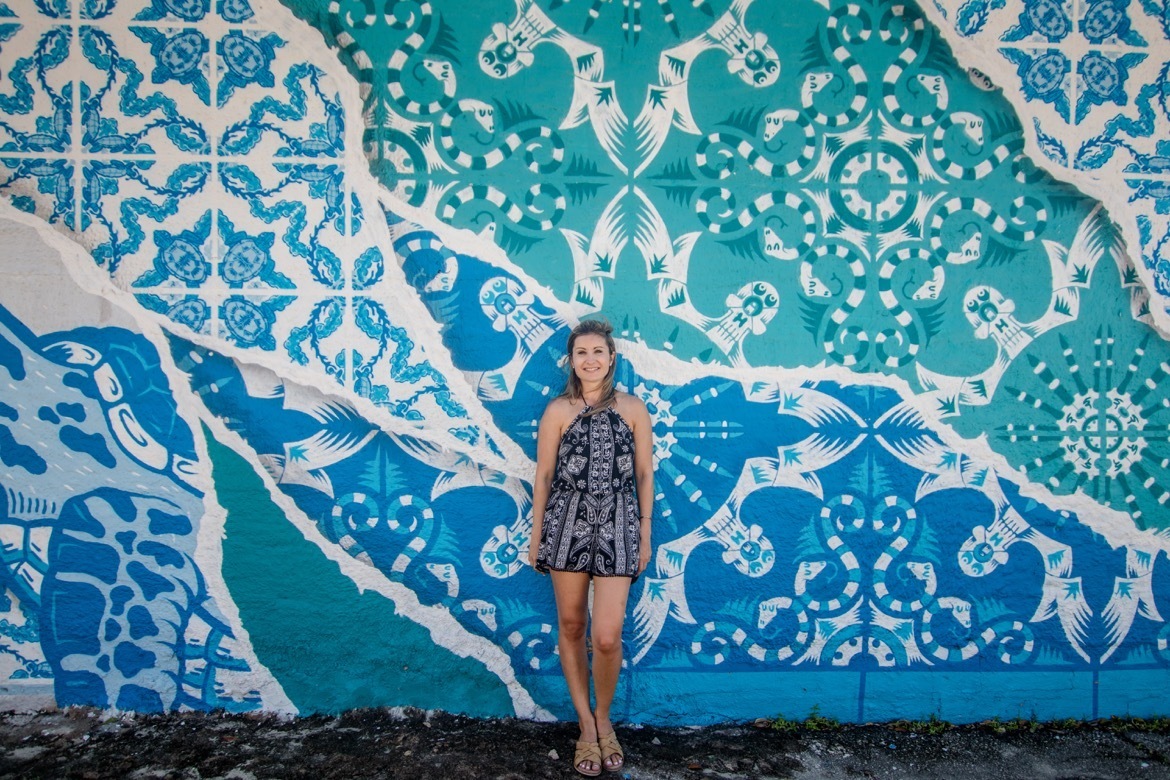
San Nicolas street art
Most visitors come to see the town’s famous art-lined walkways, which provide a vibrant contrast to the otherwise arid surroundings. Two-storey high fluorescent flamingos, seashells fashioned into angel wings and neon cacti sculptures are among the colourful creations that showcase local talent.
Comprising about five blocks, it takes about 30 minutes to see the Main Street murals, before ducking into the small boutiques and galleries tucked amongst the artworks. This is a great spot to pick up souvenirs you’ll actually want to keep, like handcrafted jewellery, accessories and prints.
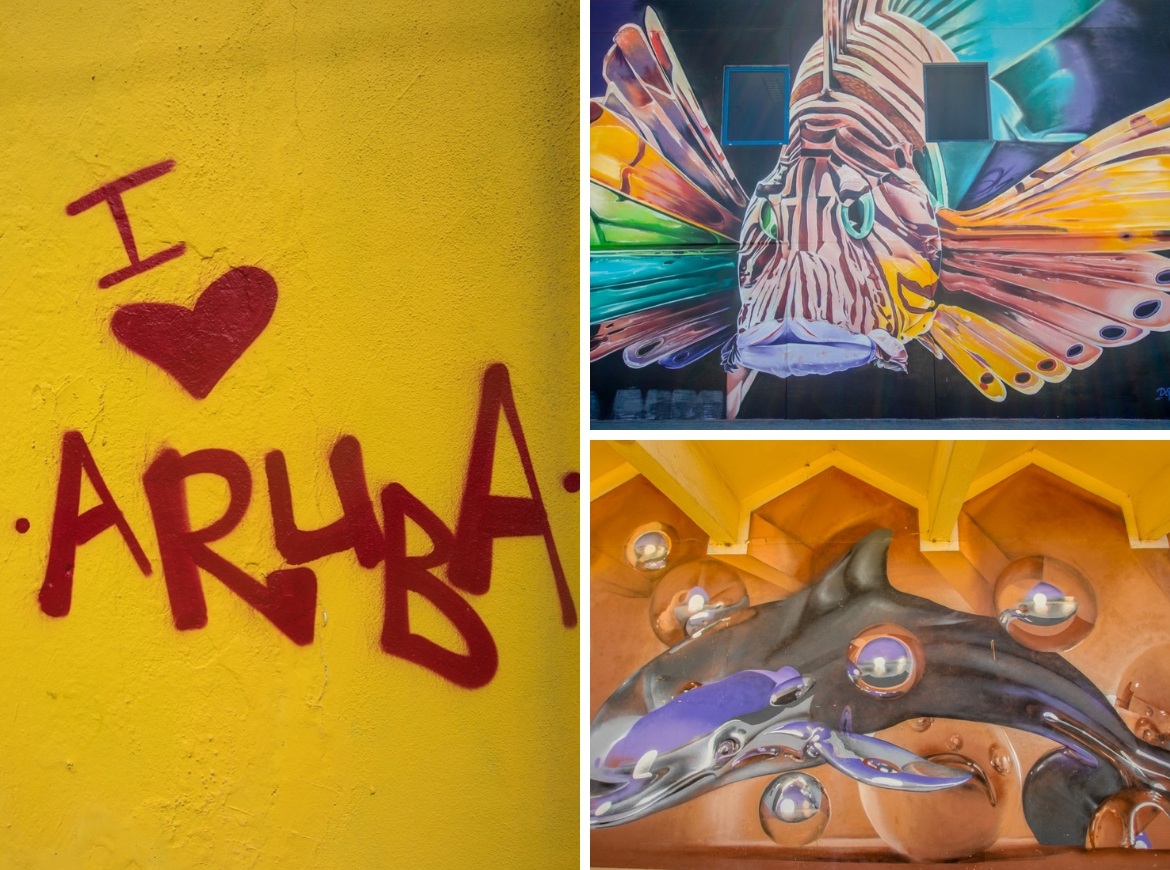
Today, a dizzying area of memorabilia from a royal crown to a Popeye figurine to license plates are on display, and visitors are encouraged to leave something behind to add to the always-growing collection.
Relax on the best beaches in Aruba
One of the best reasons to visit San Nicolas is that it’s the gateway to some of Aruba’s best beaches, including Baby Beach and Boca Grandi.
Baby Beach is a local favourite, where a serene turquoise bay is framed by the sun-kissed shoreline. Its calm, protected warm waters are perfect for families with little ones, and the far-reaching sandbars make it possible to walk over a hundred yards before the water begins nearing waist height. There’s a beach bar on site, as well as umbrellas and chair rentals.
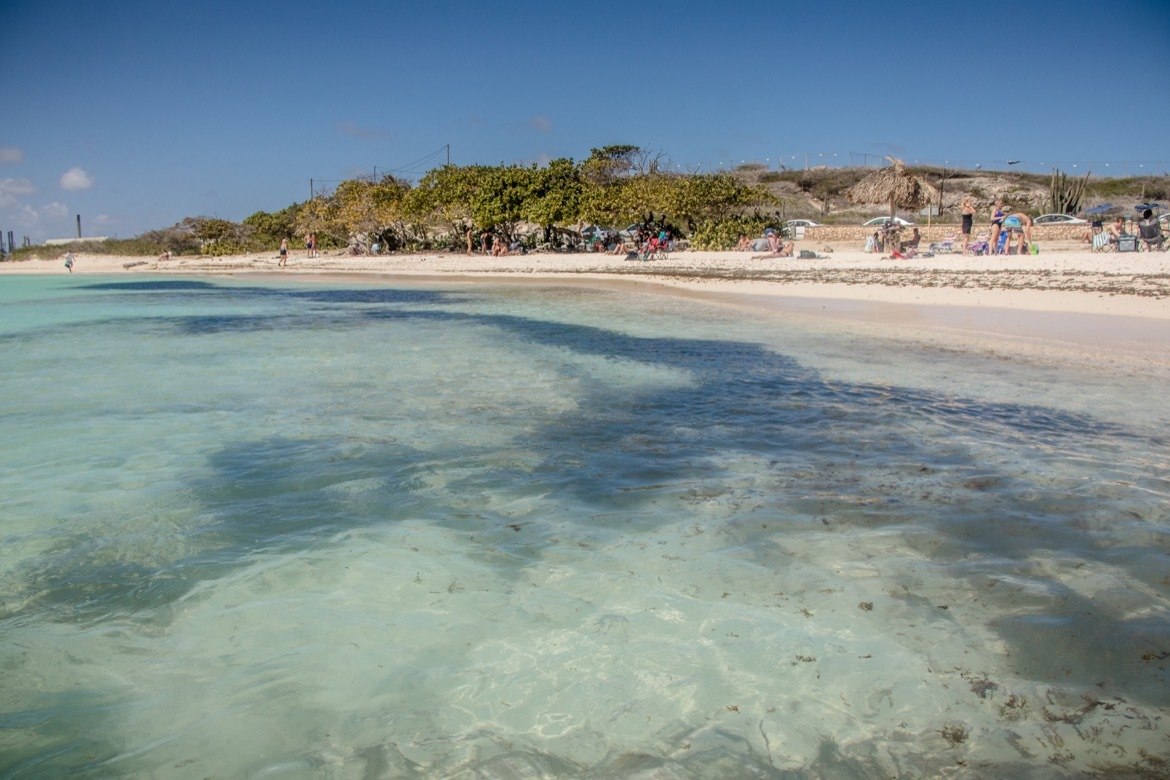
Adrenaline junkies flock to rugged Boca Grandi, a popular windsurfing spot just down the road. The wind here is unrelenting, providing the perfect conditions for surfing and kiteboarding. Even those who show up without a board in tow will love lounging on the otherwise secluded beach, where the soft sand is surrounded by rolling dunes.
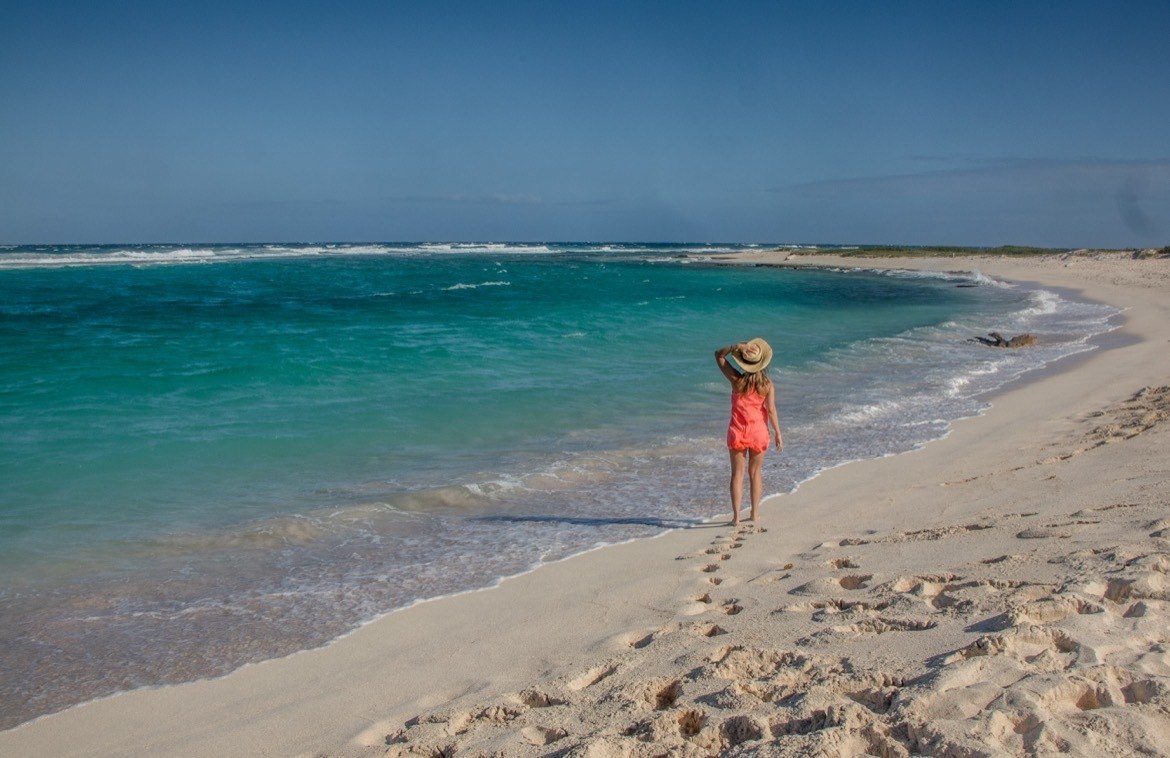
Around San Nicolas, Aruba
On the dusty, windy road leading back from the beach, chances are you’ll come across a rather quirky greeting committee: a herd of donkeys who hee-haw out a welcome to anyone who happens to pass by as they graze in the desert. This drove of furry creatures live in the Donkey Sanctuary at Bringamosa, which has a visitor centre, gift shop and tours dedicated to its 130 inhabitants.
Once the preferred mode of transportation around these parts before cars took over, a haven was created for the donkeys back in 1997 to give them a protected area to live out their days. These friendly, furry, four-legged friends now love ambling along the roadside, and will even come right up to your car window in hopes of snagging a treat.
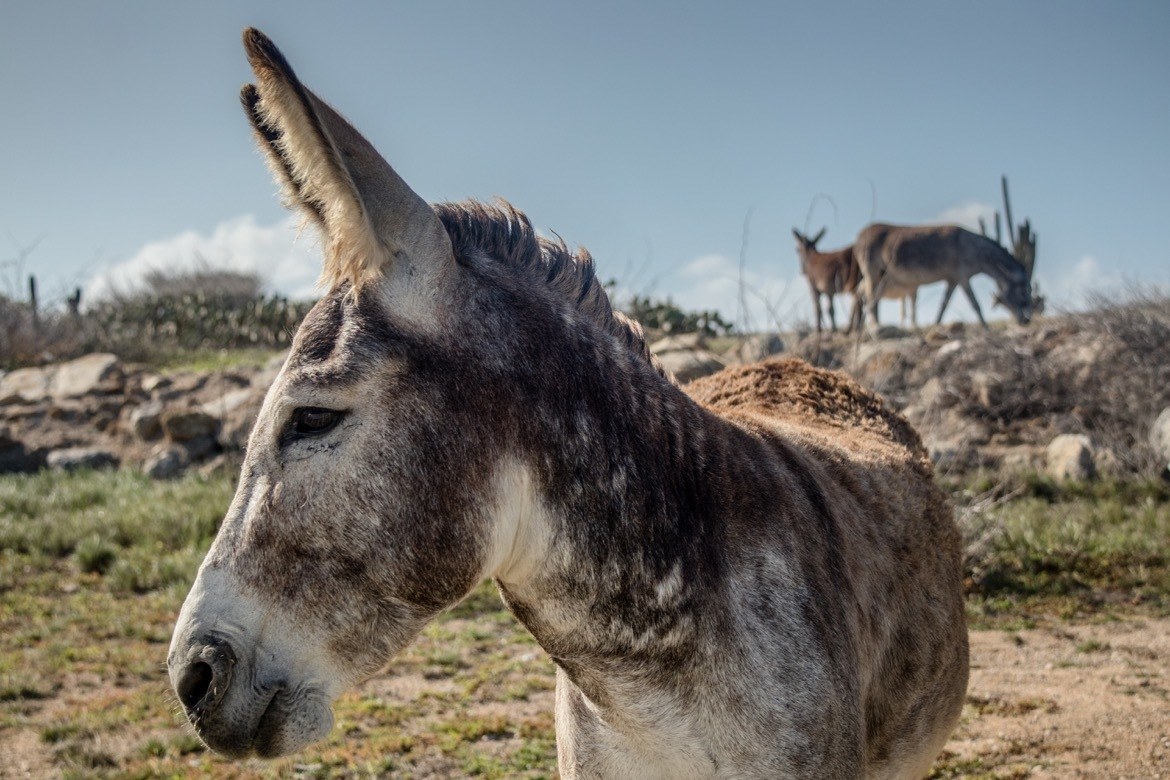
YOU MIGHT ALSO ENJOY:
- What to do in Aruba: The ultimate one week itinerary
- Playground in paradise: Fun and flamingos on De Palm Island, Aruba
- A complete guide to the different Divi Resorts in Aruba
- Secret tips for seeing the Aruba flamingos
SHARE THE PINSPIRATION! CLICK THE IMAGES BELOW TO PIN:
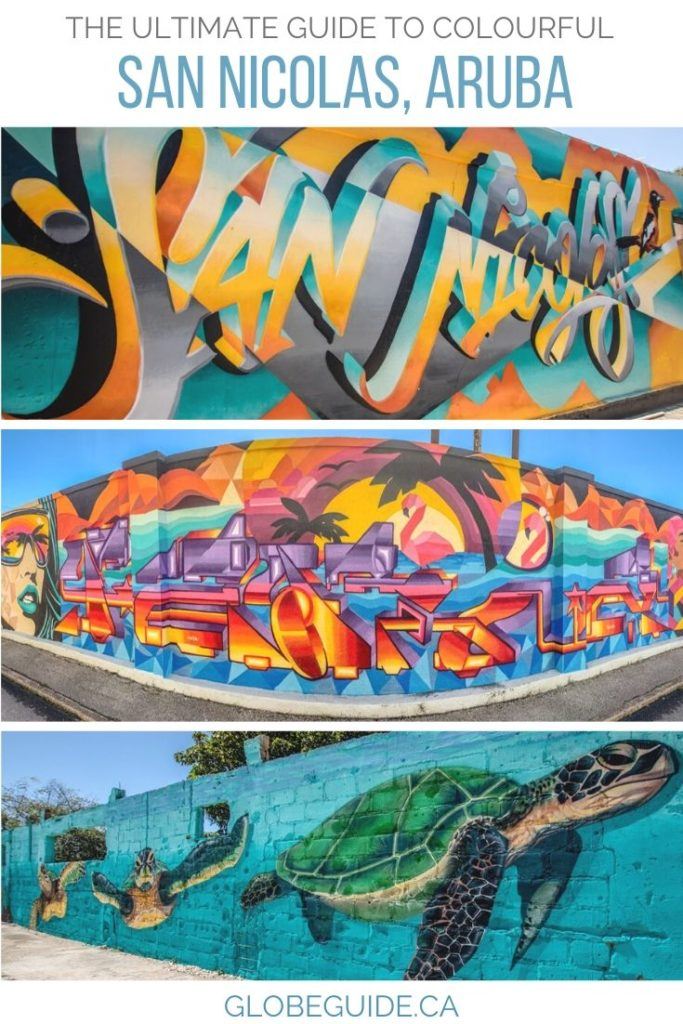
This post may contain affiliate links, which Globe Guide receives compensation for at no additional cost to you.
About The Author
Tamara Elliott
3 thoughts on “why colourful san nicolas should be on your aruba itinerary”.
Looking for a beach front luxury hotel for a single traveler in November. Any suggestions? When is the art fair?
Hi Jill, check out this article which has some accommodation recommendations and a list of all the fun things to do on the island: https://www.globeguide.ca/what-to-do-in-aruba-itinerary/ Enjoy your trip!
Hello, could you help me? Where can I find good quality acrylic paints, watercolors and brushes here in Aruba? Thank you!
Leave a Comment Cancel Reply
Your email address will not be published. Required fields are marked *
Save my name, email, and website in this browser for the next time I comment.

Home » Trips » Expedition National Park
Adult Summer Camp @ Channel Islands National Park
Liveaboard 5 days/4 nights, as low as $2,095 per person (2 or more in your party), 2024 departures, july 18 - 22 space available august 18-22 sold out.
Escape the modern world and reconnect with your roots at the Channel Islands National Park & Marine Sanctuary – hiking, kayaking, diving, snorkeling, you name it! Its like SUMMER CAMP FOR ADULTS!
- Secure Your Spot Now
Adult Summer Camp Highlights
A journey through the channel islands national park and marine sanctuary.
We are a unique group of explorers that know these islands, where to paddle, where to snorkel/dive, and what to do when the weather is incredible… and also what to do when it’s not!
- Explore Channel Islands National Park on a unique multi-sport adventure that offers world-class snorkeling, kayaking, hiking, wildlife, and much more – Summer Camp for Adults!
- Swim and snorkel through kelp forests and see abundant underwater life.
- Kayak through sea caves and arches along the dramatic volcanic coast line.
- Hike on Santa Rosa, San Miguel, Santa Barbara, and Santa Cruz Island
- Ocean wilderness experience, you’ll be in a remote area with the experts.
- Guides and naturalists share knowledge of Channel Islands National Park
- Nightly presentations about the islands’ natural and cultural history
- Healthy and delicious food served everyday.
- 5 star galley services w/ beverage bar

Adult Summer Camp Details
This All Island National Park Expedition is the flagship of our company. We have been leading this for private groups for 20 years and we’re now bringing this unique itinerary and experience to the public for the first time ever!
Luggage Drop off is starts at 10am on day 1 with check-in at 6:30pm for the welcome dinner and safety briefing. At this time your Expedition Leader and guides will share the plan for the next 4 days. Our itinerary is based on weather, but we start each day with a kayak paddle at a special remote destination and spend the afternoon either hiking, fishing, snorkeling, or relaxing (or a combo of all of that!). Food is cooked fresh each day and our galley takes special care in accommodating special diets and keeping the food hearty and healthy. Throughout the expedition your guides and crew will present information about each area we visit and each evening we offer a presentation on a topic relevant to the Channel Islands. To truly experience the Channel Islands you need to be on a smaller expedition vessel with the ability to land at the remote islands by small craft.…
Important Times
- Pre-boarding: 10:00 AM-6:30pm (you may drop your gear off in our secure bunk room)
- Check In Welcome Dinner and Safety Briefing: 6:30pm
- Duration: 5 days, 4 at the islands, and 4 nights
- Return to Santa Barbara: by 5:00 PM on the fifth day
Your Expedition Vessel – VISION
- Overnight Capacity – 24-28 people in 12 oversized and 16 personal bunks.
- Bunks are dressed with pillows, blankets, and privacy curtains.
Destinations
San miguel island, santa rosa island, santa cruz island.
- Santa Barbara Island (under special circumstances)
Anacapa Island
Trip specific information.
- Minimum Age: 18 years old
- Maximum Number of Guests: 28
Departure Harbor
Santa Barbara Landing – Santa Barbara Harbor 301 West Cabrillo Blvd Santa Barbara, CA 93101

Healthy and Delicious Food Served Fresh from our Galley
We source most of our produce from the local farmers’ markets in order to serve a seasonal, sustainable, and healthy menu.
We can accommodate the following diets and ALL severe food allergies:
- Gluten Free (we do not provide gluten free bread)
Here is a Sample Itinerary:
- 7am continental breakfast
- 7:30am wake-up call
- 7:30-8:30 am hot breakfast served in the expedition lounge.
- 8:30am Expedition team briefing about the plan for the day
- 9:00a-12p morning ocean operations (kayaking)
- 12:30-1:30pm lunch and repositioning of the vessel.
- 2:00-5:00 afternoon land operations (hiking)
- 5:30-7:30p snorkeling, diving, reading, journaling, happy hour
- 7:30p Dinner in the expedition lounge .
- 9pm-10pm Evening entertainment
- 10p-7a quiet hours
- Departure from Santa Barbara
PRE-BOARDING
Boarding begins at 10am so you can leave your gear when you arrive in Santa Barbara on board and then go enjoy the shopping and food in downtown which is a short walk from the boat.
We invite you to take out kayaks from our harbor Paddle Sports Center if you want to get comfortable paddling in calm waters before we launch you at San Miguel Island.
Starting at 6 PM we invite you to return to the boat and meet other passengers and crew members. A boarding buffet is served around 6:30 pm. The boarding gates close at 9 PM
GET TO KNOW YOUR NATIONAL PARK AND CREW
During our boarding orientation we’ll pass out National Park literature and maps so you can get situated with where we’re going and follow the captains plan for your island expedition.
We have a large crew for our expeditions, so you’ll have a chance to meet everyone and they’ll get a chance to meet you, the guests.
Our style is to always share some useful information and we’re always open to questions and side conversations. There is a lot to share and more to learn, so we’ll try to keep things brief but interesting!

AFTERNOON HIKING There are several trails that traverse San Miguel Island, providing a variety of hikes. Many parts of the island are closed to protect wildlife, fragile plants, and geological features. Hikes outside of the Cuyler Harbor beach, Cabrillo Monument, and Lester Ranch are done with a qualified naturalist or park ranger. A vigorous 16-mile hike to Point Bennett will take you to see one of the most spectacular wildlife events on our planet: over 30,000 seals and sea lions sunning themselves on the point, depending on the season. There is no pier on San Miguel Island so all landings are done by skiff at Cuyler Harbor. Landing on the island can be an exciting experience as the surf can make the landing challenging.
San Miguel Island is more prone to receive the brunt of any weather systems that move through the area. Most of the time a strong northwest wind blows across the island and these winds typically exceed 25 mph and can surpass 50 mph. When strong high pressure is over the mainland, the winds often cease creating a surreal environment. On warmer days the fog will burn off only to have the strong northwest wind blow in additional fog from the open ocean. On foggy days the temperature will rarely exceed 55°F.

PERHAPS SOME DIVING & SNORKELING San Miguel has some of the most spectacular scuba diving found anywhere off the coast of California. On any given day the water can be 10 to 15 degrees colder at San Miguel so proper equipment (7 mm wetsuit minimum or drysuit) is needed to enjoy this remote dive location. The topography at its offshore pinnacles makes a diver feel small. Mountainous pinnacles can go from 20 feet of water to 200 on some walls. More varieties of seals and sea lions can be viewed here than on any other Channel Island. Protected coves, banks, offshore rocks, and pinnacles make this a sought-after destination for SCUBA divers. Weather protects this island from frequent human visitation. A nice day at San Miguel is about as good as it gets.
MORNING KAYAKING Kayaking at Santa Rosa Island is a fascinating way to experience the wild and rugged coastline of this remote place. The sandy beaches and cliffs are breeding and resting areas for sea birds, seals, and sea lions. Kayaking is often the best way to view all the unique wildlife on the island without disturbing animals in their natural habitat. As with San Miguel, inclement weather may strike at any time. Weather conditions can affect the difficulty of paddling at Santa Rosa.

A variety of Torrey Pine ( Pinus torreyana var. insularis ) grows on the island. The population of this endangered species is estimated at approximately 1000 trees. This ancient grove is just a remnant of a much larger forest of Torrey pines that once existed in the Pleistocene era, some 12,000 years ago. A trail that leads to this exceedingly rare species of pine tree can be accessed from Becher’s Bay, the island’s main landing.
Keep a sharp eye out for the Island fox, Spotted skunk, and Munchkin dudleya ( Dudleya gnoma ); one of the six endemic plant species on the island.
EVENING FISHING AND RELAXING
After the days planned kayaking and hiking are complete you’ll have free time to relax, meet someone new, read a book, or cast a line and see what you can catch.
MORNING KAYAKING Given it’s ample 77-mile coastline, Santa Cruz Island has a vast number of kayaking destinations that you are able to visit with Channel Islands Expeditions. An expedition with CIEX is the only way to see a vast majority of the island’s scenic shoreline, as most of the island itself is closed to conventional tourism.

AFTERNOON HIKING There are several hiking trails and roads that traverse the eastern portion of Santa Cruz Island which is part of the Channel Islands National Park. While visitors may explore this section, no hiking is allowed beyond the national park boundary onto The Nature Conservancy property to the west without first obtaining a permit. Landings onto Santa Cruz are either by pier or by skiff. Potential landing areas include Prisoners Harbor and Smugglers Cove.
Once on Santa Cruz, a well-marked trail system will take you to several scenic overlooks of the island’s coastline, as well as to areas of natural and historical significance. Consult your Channel Islands Expeditions trip leaders as to what may be possible on your expedition, as there are many places to explore on this island. Wherever you go, be sure to keep a sharp eye out for some of the island’s many endemic species found here, including the island scrub-jay and the island fox.
EVENING DIVING & SNORKELING
Santa Cruz Island offers the most diverse array of dive sites out of all eight Channel Islands. Warm southern and colder northern currents create unique marine habitats for many different species. Being the largest of California’s Channel Islands, there is a wide variety of different dive spots to explore around Santa Cruz Island, each with its own unique characteristics. Santa Cruz offers more places to find good diving during rough weather periods than any other island due to its size (Santa Cruz is the largest Channel Island).
Anacapa Island is a small volcanic island located 14 miles off the coast of Ventura County. The smallest of the northern Channel Islands, Anacapa was used intermittently by the indigenous Chumash people for thousands of years. Juan Rodriguez Cabrillo was the first European to discover Anacapa in 1542, calling it “Vela Falsa” or false sail. In 1793, Captain George Vancouver christened the island Anacapa, a name derived from the Chumash word, “’ Anyapax,” which translates to ‘illusion’ or ‘mirage.’ Anacapa is the only Channel Island to maintain its original Chumash name. Anacapa’s dramatic sea cliffs are often shrouded by marine haze or fog, giving the island an air of mystery.
Anacapa is composed of three islets: East, Middle, and West. Altogether, the islets make up a narrow island that is 5 miles long and only a ¼ mile wide. Ocean waves have eroded the perimeter of the island, creating steep sea cliffs towering hundreds of feet in height and exposing the volcanic air pockets, lava tubes, and sea caves. At the east end of the island, a natural bridge has formed in the ocean. This forty-foot-high arch is a trademark of Anacapa and is the symbol of Channel Islands National Park. The highest peak is on West Anacapa, rising to 930 feet.
MORNING WATER ACTIVITIES
We will begin our day by loading onto the kayaks and beginning the Eastward paddle down the snaking island where the most sea caves per mile exist on the planet. We explore these coves on our kayaks, and if conditions are ideal, we’ll stop for an underwater experience.

AFTERNOON HIKE
A short hike to the top of Anacapa Island brings you to the most iconic overlook in the National Park, and perhaps California… inspiration point. Looking to the West you can see as far as Santa Rosa on a clear day.
Frequently Asked Questions
How many people can fit in an oversized bunk.
Each person is assigned a bunk, you may reserve an oversized bunk for $100 additional. Each bunk has a privacy curtain. Our nightwatch crew is there for the safety of passengers and the vessel.
Can I bring SCUBA gear?
Yes, you are welcome to bring SCUBA gear. We have air compressors to fill tanks, so you only need one tank. We do not carry tanks or weights, but you can get both from Dive Santa Barbara @ Landing prior to our departure.
We may only have the chance for 1 dive per day , and we may not be able to dive everyday. Once we get to Santa Cruz Island and Anacapa Island, we have more chances for diving.
This is not a typical dive trip where we are focused on finding great diving all day long, we must find a place that is good for diving and snorkeling, so this may mean shallow dives.
If you have questions about diving on the Expedition, call us at 805-899-4925.
What does our itinerary look like?
The true definition of an “Expedition” is that we don’t know exactly what we are going to do until we have a reliable weather forecast. The forecast reliability window is about 24 hours. We have many tricks up our sleeves and we know how to make the best of the weather we are handed. But our daily itinerary changes based on weather.
Because of that here is a sample itinerary for a day:
What does check-in day look like?
You can drop off your gear anytime after 10am and head out to enjoy lunch and shopping in Santa Barbara. At 56:30pm you can begin boarding with crew and get to know the other passengers during our welcome dinner and briefing. After dinner and briefing you can retreat to you bunks and we get underway in the middle of the night on our way to the Channel Islands. You’ll wake up the next morning to a lost world where wildlife and breathtaking landscapes are your backdrop to breakfast and coffee.
What is the Age Limit?
The minimum age for this trip is 18 years old.
Do I need to know how to swim?
In order to snorkel you must know how to swim. You can kayak by just being comfortable floating in a PFD. You don’t need to be excellent at swimming laps, but you need to be comfortable treading water and being in deep water.
How difficult is the kayaking?
Generally, the level of difficulty of kayaking on this trip is beginner to intermediate and downwind for the most part. Since we are vessel-supported, all of the paddling will be downwind. However, you may have to paddle in a range of conditions so we recommend that participants be in reasonable physical shape and comfortable on the ocean.
What is your cancellation policy?
100% credit up until 10 days prior to departure.
- All sales are final unless we have to cancel due to weather.
- You can get a 100% credit for a future trip 10 days or more from your departure date.
- We do not accept changes within 10 days unless in some extreme cases.
- If you purchase CIEx Trip Protect, you can get a full refund for each ticket protected at anytime* for any reason .
*No same day cancellations please, this makes our morning very difficult as we try to locate our missing paddlers before we leave!
Customer Reviews of our Expeditions
Explore channel islands.
(805) 899-4925
Departure Location Information
Be sure to check your confirmation email before leaving for your trip, these harbors are 45 minutes from each other!
Detailed Directions for Trips:
Departing Santa Barbara Harbor
Departing Marine Emporium Landing Channel Islands Harbor, Oxnard Shores
Quick Links
- Summer Camps
- Join the Team
- Gift Certificates
- Homepage Image by Glenda Sandberg
© 2024 Channel Islands Expeditions.
- EPIC Sea Cave Combo Day Trip Downwind Kayaking – Kelp Forest Snorkeling Departs from Oxnard Harbor on the 54′ SUNFISH
- Painted Cave Combo Day Trip Downwind Kayaking – Modified Snorkeling Departs from Santa Barbara on the 64′ TRUTH
- 5 Day Expedition National Park Adult Summer Camp The only all island National Park cruise that checks all of the boxes!
- Call Us: 805-899-4925
- Santa Barbara Departures
- Oxnard Departures
- SCUBA Dive Charters

We are a local, family-owned company that employs professional crew with decades of experience. As owner/operators we are engaged in our daily operations. It takes a lot of human power, planning, and training to operate a safe and sound fleet and team, and we take pride in the expeditions we run.
Traveling to the Channel Islands from the mainland is a distance ranging from 11 to 45 miles (one way) depending on where we depart from and where we go. This journey consumes both time and fuel. Crew and fuel costs account for 50% of the cost of our operations. We operate in US Waters and our vessels are inspected semi-annually by the United States Coast Guard.
In 2022 we underwent 3 USCG full-vessel inspections (top and bottom side) with ZERO MAJOR* deficiencies and one vessel with ZERO overall deficiencies (TRUTH). Our commitment to running the safest small boat expedition fleet in the world requires resources, and our safety record indicates our resources are going to the correct places.
Here’s a simple breakdown of the costs per ticket:
The number of passengers on the vessel does affect this breakdown, and so if you’re choosing an expedition or a summer camp with a 24 passenger load, this is why your ticket cost is higher than a full capacity expedition.
Thank you for understanding and supporting these amazing California Expeditions!
CIEx Family
*Minor deficiencies must be corrected within 30 days, major deficiencies must be corrected before carrying passengers again. We correct minor deficiencies as soon as possible.

Expedition Blue Season Pass – 2023 Season
- 2 redemptions for any “Boat Trip Only” ticket per month
- 1 redemption for any “Kayak Expedition” ticket per month
- 1 redemption for any “Snorkeling Expedition” ticket per month
- 4 redemptions for “Santa Barbara Sunset Boat Cruise” per month
- 10% discount on the “Ultimate 5 Day”
- 10% discount on the “Ocean Explorers Liveaboard Camp”
Value – over $3,000 for the season!
Cost – only $399/person/year.
Only Sold Through May 1, 2023
Cortes Bank
Cortes Bank is a chain of underwater pinnacles and plateaus located 137 nautical miles (nm) South by Southeast from Santa Barbara and about 40 nm Southwest of San Clemente Island. Bishop Rock is one of the peaks in the underwater mountain chain that rises to within 6 feet of the surface and is marked by a nearby warning buoy. It was named for the clipper ship Stillwell S. Bishop that struck the rock in 1855 and with a patched hull limped its way back to San Francisco. Nine Fathom spot is about 4.5 miles Northwest of Bishop Rock and rises to about 60 feet below the surface. Both are noted scuba diving locations featuring clear water and abundant sea life.
Scuba diving Cortes Bank with Channel Islands Expeditions is a truly unique experience. It is an open water seamount where currents sweep clean ocean water over the spot and invertebrates cling to the rocks. Sea palms ( Postelsia palmaeformis ) fixed to the rocks provides shelter for smaller fish and invertebrates that hide amongst its fronds. Large clusters of purple hydrocorals can be seen throughout the area as well as tuna, yellowtail, large schools of baitfish, sea lions, and occasional sharks. Large black and white sea bass are common sights as well California sheep head. Lobster divers continue to make this spot a top priority to visit during season and free divers frequent the area in the spring and summer for yellowtail, white sea bass, and tuna. Wreck diving can also be done at this location on the Abalonia .
Diving at Cortes Bank can be spectacular but anyone who ventures out there needs to be mentally and physically prepared. On any open ocean dive location, one needs to understand that ocean swells and currents are normally present. A flat calm day is rare. When you get good conditions at “The Bank” it will be a dive you will not forget. Sometimes it can be frustrating to get to the bank, but when you do, it can be well worth the effort.
In 1969 a group of promoters bought the World War II surplus troop ship SS Jalisco , renamed her USS Abalonia , and sailed her to the bank intending to sink her in shallow water to form a tax-free island nation and shellfish processing plant. But during the sinking, rough seas broke a mooring line and pushed her into deeper water. Another company planned to build a platform on the bank and form a nation called ‘Taluga,’ but the US government declared that the bank was part of the continental shelf and was US territory. The wreck of the Abalonia today lies in three pieces in about 30 to 40 feet of water. Now, only scuba divers and the vibrant marine life are citizens of this almost-nation.
On November 2, 1985, the nuclear-powered aircraft carrier USS Enterprise struck Cortes Bank about one mile east of Bishop Rock during exercises, putting a 40-foot gash in her outer hull and damaging a propeller. She continued operations then went into dry dock at Hunter’s Point Shipyard in San Francisco for repairs.
Tanner Bank
Tanner Bank is a chain of underwater pinnacles and plateaus located 120 nautical miles (nm) south by southeast of Santa Barbara, California, and 35 miles West by Southwest of San Clemente Island This bank rises within 80 feet of the surface and is considered one of the best advanced open water dive locations on the California coast. Like Cortes Banks, this seamount is open ocean with exposure to wind, current, and swell. Timing is everything when it comes to a successful day of diving this spot.
Scuba diving with Channel Islands Expeditions at Tanner Bank offers no protection from the weather so anchoring overnight is truly rare. Diving the bank is generally done on a multiple day liveaboard trip when you can take advantage of a weather window and dash out for a day. This dive location is so far offshore and exposed to the elements, so a diver can get a true feeling of open ocean diving that you cannot get next to land.
Under most circumstances this is considered advanced diving. It is deep and there can be current and surge, but the payoff can be huge. Like any other open ocean dive spot, you must be willing to roll the dice and see what Mother Nature will dish out.
This is an open water seamount, so currents sweep clean ocean water over the spot. You’ll find that everything that lives here clings tightly to the rocks. Palm kelp fixed to the rocks provides shelter for smaller fish and sea life that hide amongst its fronds. Large clusters of purple hydrocorals can be seen throughout the area as well as tuna, yellowtail, large schools of baitfish, sea lions, and occasional sharks. Lobster divers have scored well in this location at times and many a sea story have been written once aboard the Truth and Vision.
Santa Catalina Island
After Alcatraz, Santa Catalina Island is probably the best known of any of California’s islands. This island’s proximity to Los Angeles transformed it into a popular tourist destination, evidenced by its one million visitors each year. The island is 22 miles long and eight miles across at its greatest width. The highest point on the island is Mt. Orizaba 2,126 feet. The island was widely developed as a resort by chewing gum magnate William Wrigley Jr. Now, ninety percent of the island is owned by the Catalina Island Conservancy, with the remainder of the island under the ownership of private entities.
The island is a rugged terrain of ridges and canyons with a few valleys inland and on its coastal fringes. The island is a semi-arid with only 12 inches of rainfall each year, though the marine climate does moderate temperatures during the summer and winter. The majority of the terrain here is characterized by chapparal vegetation with pine forest interspersed in canyons and at higher elevations.
Catalina Island is well known for its calm, clear, and warm waters. Even though Catalina is the most populated dive site of any other Channel Island, it is still sought out by scuba divers around the globe. Any trip with Channel Islands Expeditions is sure to encounter verdant kelp forest full of garibaldi, yellowtail, kelp bass, white seabass, giant black sea bass, and leopard sharks, as well as many other intriguing species. Photography and sightseeing are especially good in these clear waters, though free divers enjoy the possibility of spearing yellowtail and white seabass. Channel Islands Expeditions makes this destination part of its itinerary on the southern islands multi-day dive excursions, mostly during the summer months.
Scenic coastlines and warm waters make for the perfect opportunity to paddle, swim, and snorkel away an afternoon in beautiful surroundings. Your expedition leader will choose amongst the variety of sheltered coastal paddling opportunities that may present themselves on an adventure to Catalina Island with Channel Islands Expeditions.
There are many hiking trails along Catalina Island. Beach walking is allowed for anyone, but a permit is required for any back country travel. Permits can be acquired through the Catalina Island Conservancy. A point of pride for the island is the Trans-Catalina Trail, a recently finished 37.2-mile track that spans from Avalon on the east end of the island, past the isthmus, and ending at Starlight Beach on the west end.
Human History
Archaeological evidence shows Catalina was occupied by ancient cultures at least as far back as 6,800 years ago. The most recent native peoples to occupy the island were of the Tongva culture, whose languages and traditions were distinct from the Chumash of the northern Channel Islands. The Tongva referred to the island as “ pimu ” and to those that lived there as “ pimuvit .” Large settlements dotted the coastline of pimu , and the pimuvit were renowned for the quarrying and trading of soapstone, which they excelled in carving.
The island would be discovered on Juan Rodriguez Cabrillo’s foundational voyage of exploration in 1542. The colonization of California by the Spanish brought about the swift disintegration of the Tongva people, including those that resided on Santa Catalina Island. Over the years, the island would change hands and small ranchos were established, but it was not until the turn of the 20th century that anyone would have designs on turning Catalina Island into a tourist destination. A real estate developer from Michigan named George Shatto created the settlement that would become Avalon and built its first hotel and pier.
William Wrigley Jr. acquired the majority of the Catalina Island Company in 1919, when he bought the island as an investment, but was so enamored by it he decided to keep it and develop the island so as to make it accessible to anyone that might like to visit. Wrigley subsequently, invested millions of dollars in the island, building and modernizing utilities and buildings in and around the now famous city of Avalon. He made it the spring training location for the Chicago Cubs built the iconic Catalina Casino building in 1929. The Wrigleys later donated 42,000 acres of land to the Catalina Island Conservancy for preservation.
Natural History
Santa Catalina Island’s diversity in flora and fauna is second to only Santa Cruz Island in the Channel Islands chain. Its proximity to the outflows of the Los Angeles, San Gabriel, and Santa Ana river basins opens the island up to a higher probability of species “rafting” over to the beaches of Catalina. This naturally leads to isolation and speciation, and as a result, Catalina is home to five native land mammals: the Santa Catalina Island Fox ( Urocyon littoralis catalinae ) being the most well-known among them. It is home to a diverse array of endemic birds, reptiles, insects, and plants. Interestingly, it is the only Channel Island to have a native rattlesnake population.
DDT, a pesticide that was outlawed in 1972 wreaked havoc on California’s marine ecosystem and was especially consequential for the island’s native population of Bald eagles. DDT was absorbed by the birds’ major prey, fish, and then ingested by the eagles. It caused the eagles to lay eggs with weakened shells that cracked under the adults’ weight during incubation. DDT poisoning eventually extirpated the Bald eagle from California’s Channel Islands. The Catalina Island Conservancy and the Institute for Wildlife Studies (IWS) have been working in a long-standing relationship to restore Bald eagles to the island for decades. To assist the eagles, IWS biologists began retrieving the fragile eggs, hatching them off-site in incubators and returning healthy chicks to the nests, where the parents accepted them back and raised them. In 2007, DDT levels had finally decreased enough to allow bald eagles to successfully hatch eggs in the wild, when five eagle chicks hatched naturally – the first time an eagle had successfully hatched in over 50 years! By 2009, all nests on Catalina were left to natural hatching and incubation, and in 2014 and 2020 four more Bald eagle chicks hatched and fledged in nests around the island.
A herd of American Bison were supposedly first imported in 1924 for the silent film version of Catalina Island resident Zane Grey’s western novella, “The Vanishing American,” still roam the island. Over the decades, the bison herd grew to as many as 600 individuals, though the Catalina Island Conservancy concluded that a population of 150-200 individuals would reduce the impact of these non-native animals on the native flora and fauna to a sufficient degree. The herd was managed to the point where only 100 animals remained in 2020. To bolster the herd’s genetics, the Catalina Island Conservancy introduced two pregnant females in 2020.
SANTA BARBARA ISLAND
Santa Barbara Island (639 acres) is 1.67 miles across at its longest point and lies 73 nautical miles (nm) Southeast of Santa Barbara. Santa Barbara Island is the smallest of all of California’s Channel Islands and the southern-most member of the Channel Islands National Park. Like most of the Channel Islands, it can be seen from the mainland on exceptionally clear days usually in winter, though the island’s profile is markedly lower than those of its bigger counterparts. The highest peak on the Santa Barbara Island is Signal Hill, at 634 feet. Despite its volcanic composure of Miocene basalts, Santa Barbara Island is not a volcano. The steep wave-cut cliffs of its shoreline indicate that erosion is still in its formative processes; this is one of the younger Channel Islands. Signs of a rising and falling ocean are marked into the basalt cliffs. Six wave-cut marine terraces can be found, an indication of both changes in sea level as well as tectonic uplift and subsidence (called porpoising). A 130 ft. arch dominates the aptly named Arch Point on the northeast corner of the island. Extensive colonies of birds reside on the volcanic cliffs of Santa Barbara Island as well as the two nearby offshore rocks: Shag Rock off the northerly shore (1 acre), and Sutil Island off the southwest end (12 acres). The steep cliffs and isolation from mainland predators provide safe breeding sites for thousands of sea birds. Santa Barbara Island, although small by any standard, boasts an impressive diversity in its habitats, with a few narrow rocky beaches, six canyons, and a badlands area.
Santa Barbara Island is known for its large rookery where you can spend hours diving with sea lions. Photographers get more opportunities to photograph these animals up close here than any Channel Island. The playful, curious pups will pose and frolic in front of a diver’s lens as long as one can stay in the water.
Diving Santa Barbara Island with Channel Islands Expeditions will take you to a host of incredible sites around the island, including the famous undersea “Arch.” The top of the reef just breaks the surface at low tide and the bottom of the arch lies in 40 feet of water. One of the more unique underwater arches in the world it makes the perfect backdrop for photographers. In addition to the “Arch,” there are many offshore pinnacles that are home to shear walls along with some of the largest clusters of purple hydrocoral found anywhere.
Santa Barbara has long been a prime destination for spearfishing. Warm southern currents coupled with lush kelp beds make this island attract a wealth of game fish. Calico bass, white sea bass, yellowtail, and an occasional tuna are among the species that can be found in the waters surrounding this island. As with all Channel Islands, a healthy spiny lobster population makes this a favorite destination during season.
Santa Barbara Island can offer some of the best scuba diving found in Southern California but if conditions are rough there are not many places to go.
Similar in many ways to Anacapa Island, kayaking Santa Barbara Island offers the perfect setting for this water sport. Weather permitting, your expedition leader may decide to attempt a complete circumnavigation of Santa Barbara Island. Wind and swell can be a factor, so attempting this trip is best done on one of Channel Islands Expeditions multi-day adventures. Kayaking long distances with a support vessel offers an added layer of safety for an unforgettable journey around this hidden gem of the Pacific.
Hiking on Santa Barbara Island will provide you with one of the most remote island hiking experiences of any of the Channel Islands. Don’t be fooled, the steep incline of this island can offer a challenge to just about anyone, but just beyond that you will find five miles of hiking trails with gentle rolling hills and breathtaking panoramic ocean views.
Though is thought to have never been permanently inhabited, Santa Barbara Island may have played a crucial role in the lives of the island peoples who occupied the surrounding Channel Islands for well over 10,000 years. Archeological evidence suggests that Santa Barbara Island may have been a convenient stopover on inter-island trade routes, a testament to its central location in the Channel Islands chain. The rich marine life found here may have drawn people to seasonally harvest the shores of this island for shellfish, seals, and fish. Recent studies indicate this may have begun about 4,000 years ago.
The first European visitor to the Channel Islands in 1542, Juan Rodriguez Cabrillo, a Portuguese explorer, made no mention of this island. Sixty years later, the island was named by Spanish explorer Sebastian Vizcaino, who visited the island on December 4, 1602, the feast day dedicated to Santa Barbara. The island was infrequently visited in subsequent years, owning largely to its sparse vegetation and lack of a reliable water source. Santa Barbara Island did play host to an assemblage of seal hunters, squatters, fishermen, and the occasional whaling ship off its shores.
A few notable individuals eked out a living here, chief among them the family of Alvin Hyder. After a winning bid of $250 in 1916, Hyder and his family assumed ownership of the island and were the first to establish a residence of any permanence there. Hard work and a constant struggle to maintain a supply of fresh water were trademark features of a tough existence on this island. Santa Barbara Island would become a part of the Channel Islands National Monument in 1938 and was utilized as Coastal Lookout Station during WWII. Santa Barbara Island became part of the Channel Islands National Park upon its establishment in 1980.
Santa Barbara Island is home to a large sea lion rookery and seabird nesting colonies, including three species of storm-petrel, three species of cormorant, and the once-endangered California brown pelican. It is also home to the largest breeding colony for the Scripps’s Murrelet, a threatened seabird species. Scripps’s murrelet is listed as vulnerable, and is mainly threatened by oil spills, as the population exists in such a small area and is adjacent to the heavily trafficked shipping lanes that connect to the Port of Los Angeles. Spring rains bring out the flowering plants, such as the Giant coreopsis, the endemic Santa Barbara Island live-forever (Dudleya traskiae), shrubby buckwheat, sea blite, and an annual poppy. There is a visitor contact station and museum on the island with exhibits, dioramas, and murals of the natural and cultural resources.
San Nicholas Island
San Nicolas Island is the most remote of California’s Channel Islands lying 78 nautical miles (nm) south by southeast from Santa Barbara and 53 miles from the nearest coastline. Rising out of the rolling Pacific swells, the 14,500 acre (23 square miles) island is defined by wave cut terraces and windswept, grassy hills. It is currently controlled and operated as a weapons testing and training facility by the United States Navy. The island has a small airport and the several buildings supporting the naval operation are affectionately referred to as ‘Nictown.’ Landing on the island is strictly prohibited and one of the offshore water areas is restricted from transiting or anchoring.
Channel Islands Expeditions travels out to San Nicolas Island during the summer and early fall to dive the iconic Begg Rock and some of the island’s nearshore reefs. Begg Rock is a small rock lying almost 8 miles to the west from the island and it is one of California’s most pristine dive locations. This is open ocean diving so wind, swell, and currents can make this a difficult area to scuba dive. When the conditions are right, this dive will not be forgotten. Shear walls covered in corynactis anemones paint this dive in a rainbow of colors. In the fall, the island itself is a popular lobster diving area when they are in season. Its remote location means that a trip to San Nicolas implies a chance of encountering unstable weather. A day of unfavorable conditions can result in tough diving in this open ocean environment. However, or those up for the adventure, a good day of weather will result in one of the most unique and unforgettable dive experiences you can have at the Channel Islands.
No kayaking is available due to a mandatory 300-yard distance from shore regulation.
No island hiking available as landing is prohibited.
San Nicolas Island shows signs of habitation that date back over 10,000 years. The native peoples that most recently occupied the island are referred to as “Nicholeños,” who had their own distinctive language and culture, though they were probably related to the Tongva people who lived on Santa Catalina Island. The name the Tongva have for San Nicholas is ‘Haraashngna.’ We do not know much of the language or history of the Nicholeños, as the large majority of their population was evacuated and assimilated into the California mission system. Their language became extinct soon after.
The person who would become the most famous resident of San Nicholas Island was left behind by the Franciscan padres who took the rest of the Nicholeños to the California missions. Juana Maria, as she would be known (though her real name was never found out), was the last surviving member of the Nicholeños. She lived alone on the island for 18 years, subsisting on shellfish and seal fat from the Northern elephant seals. Captain George Nidever found Juana Maria on the island in 1853, living in a crude whalebone hut. She was brought back to Santa Barbara, and was the object of much curiosity, becoming well-known for the beautiful songs she would sing. This would be short-lived though, as she died only seven weeks after her arrival to the mainland. Her story was the basis for Scott O’Dell’s Newbery Medal-winning 1961 novel Island of the Blue Dolphins. Academic curiosity about the “Lone Woman of San Nicholas Island” still persists, and after a 20-year search, archaeologists may have uncovered the cave she lived in in 2012.
The ecological diversity of San Nicholas was heavily impacted by sheep ranching for a period of over 80 years. The sheep removed much of the native ground cover until their removal in 1943. This in turn increased the rates of erosion and promoted non-native plant species to spread. Despite the degradation, three endemic plants are found on the island: Astragalus traskiae , Eriogonum grande tamorum , and Lomatium insulare .
The isolated beaches of San Nicholas are anything but lonely during the breeding season of one of the world’s largest seals. The Northern elephant seal ( Mirounga angustirostris ) hauls out here to breed each season, with an estimated 23,000 individuals occupying the beachfront to mate and give birth to pups. A bull elephant seal can weigh in at over 8,000 pounds and measure at up to 16 feet from nose to tail. The female is distinctively smaller, “only” weighing in at 2,000 pounds and measuring 12 feet in length. The island is home to about 30 percent of the wide-ranging California population
The dominant plant community on the island is coastal bluff scrubland, with giant coreopsis ( Coreopsis gigantea ) and coyote brush ( Baccharis pilularis ) the most visible components. The few trees present today, including California fan palms ( Washingtonia filifera ) were introduced in modern times. However, early written accounts and the remains of ancient plants in the form of calcareous root casts, known as ‘caliche,’ indicate that, prior to 1860, brush covered a portion of the island.
There are only three species of endemic land vertebrates on the island; the Island night lizard ( Xantusia riversiana ), deer mouse ( Peromyscus maniculatus exterus ), and island fox ( Urocyon littoralis dickey ). Two other reptiles, the common side-blotched lizard ( Uta stansburiana ), and the southern alligator lizard ( Elgaria multicarinatus ) were at one time thought to be endemic, but an analysis of mitochondrial DNA indicates that both species were most likely introduced in recent times.
San Nicolas Island is home to large populations of nesting birds. The two largest nesting populations are the Western gull ( Larus occidentalis ) and Brandt’s cormorant ( Phalacrocorax penicillatus ). These birds, along with the Island night lizard were threatened by a large population of feral cats, but after extensive eradication efforts by the US Navy and other organizations, the island was declared free of cats in 2012. The birds and once endangered Island night lizard populations immediately rebounded, and the night lizard was consequently taken off the endangered species list in 2014.
San Clemente Island
San Clemente Island is the southernmost of all eight of the Channel Islands and is located 113 nautical miles (nm) from Santa Barbara. It is 21 nm long and is 4-1/2 nm across at its widest point, with a total area of 57 square miles. The U.S. Navy acquired the island in 1934 and it has been owned and operated by various naval commands. San Clemente is also home to an auxiliary naval airfield, United States Navy SEALs training facilities, and the southern end of the island is the Navy’s only remaining ship-to-shore live firing range.
San Clemente Island is made of up of volcanic materials dating back to 5 million years ago. The terrain varies between exposed marine terraces and steep canyons dotted sparsely with freshwater springs. The island can be described as being on a ‘tilt;’ the north side rises dramatically out of the ocean (the highest point, Mt. Thirst, is 1,965 ft), while the south side has a much gentler slope to its rocky shores. With a frost-free, semi-arid climate, the island typically gets less than 6 inches of rain in a year.
Diving conditions at San Clemente Island are known for the clearest, warmest waters of all eight Channel Islands. Located in the southernmost region of California this island receives the warmest waters from the tropical currents from the south. Giant kelp beds, schools of fish, coral banks, and shear walls make this a diver’s paradise. Waters in the summer can reach over 70 degrees Fahrenheit and photographers flock to this island for some of the best wide-angle photography available in California.
Most of the prime scuba diving is located at each end of the island. The east end of the island is more protected and offers pinnacles, shear walls, and protected shallow kelp covered coves. San Clemente’s west end is more exposed to the westerly winds and swells but has some of the more prolific areas found off California. Nine Fathom Reef (it rises to 6 ½ fathoms) is a rocky structure with shear walls covered in purple hydrocoral. This is an open ocean diving location and is swept by currents and swells so diving this area can be tricky. Once dove, it is never forgotten.
Because of the military presence at the island, kayaking can be enjoyed near the boat only. As any on any of the Channel Islands, lush kelp beds, volcanic rock formations, and sea lions make kayaking well worth the effort. Generally, kayaking is done during one of Channel Islands Expeditions regularly scheduled liveaboard dive trips.
San Clemente Island is one of the best documented archeological settings in California. Archeologists have found traces of human occupation on the San Clemente Island dating back 10,000 years, a remarkable figure for an island 55 nautical miles out to sea, but consistent with results on other Channel Islands. The native inhabitants here called the island ‘ Kinipar ,’ and bore many cultural similarities to the nearby Nicholenos on San Nicolas Island. Travel between the islands was facilitated by the ‘ ti’at, ’ a plank canoe that enabled the islanders to cross wide channels and open ocean. Inhabitants here left trade materials from the northern islands and from the mainland, including Coso obsidian from the Mohave high desert. It has not been established what tribe the recent inhabitants belonged to, although the Tongva, from Santa Catalina Island and the Los Angeles Basin, are the most likely candidates. The Chumash who occupied the northern Channel Islands may have influenced the inhabitants.
The island was named by the mapping expedition Spanish explorer Sebastian Vizcaino, who spotted it on November 23, 1602; known as Saint Clement’s feast day in the Catholic tradition. The first actual visit happened much later in 1769, when the San Antonio of the Portola expedition anchored in Pyramid Cove on the south end of the island. Natives rowed out in ti’ats and exchanged gifts with the expedition, including two otter-fur robes. It was later used by ranchers, fishermen, and smugglers during the 19th century and into the 20th century. In the 1920s and 1930s the factory ships Lansing and California anchored off San Clemente Island, processing blue and fin whales, among other species, caught by their own fleets of steam-driven whale catchers.
In recent years effort has been made by several conservation organizations, including Channel Islands Restoration, to remove invasive species from San Clemente Island and promote the re-emergence of native and endemic flora and fauna. The removal of invasive ice plant has encouraged native plants, like the boxthorn ( Lycium spp .) to flourish. This is especially important as many endemic species of birds and reptiles use this native plant as cover and nesting habitat.
The San Clemente Island Loggerhead Shrike ( Lanius ludovicianus mearnsi ) is an endangered species that the Navy is taking steps to protect. The Island fox ( Urocyon littoralis ) and San Clemente Island brodiaea ( Brodiaea kinkiensis ) are notable examples of endemic species on the island. Feral goats roamed the island for centuries, reaching a population of 11,000 in 1972 when their effect on indigenous species was realized. By 1980 the population had been reduced to 4,000 and a plan for shooting remaining goats was blocked in court by the Fund for Animals, so the goats were removed with nets and helicopters.
Anacapa is a small volcanic island located 28 miles off the coast of Santa Barbara, California. The smallest of the northern Channel Islands, Anacapa was discovered by Juan Rodriguez Cabrillo in 1542. Later, in 1793, Captain George Vancouver christened the island Anacapa, a name derived from the Chumash Indian word, “’anyapax,” which means translates to ‘illusion’ or ‘mirage.’ The island’s name, the only one of the Channel Islands chain to maintain its original etymology, suits the place very well. The low rises of the sea cliffs can often be shrouded by marine haze or fog giving the island an air of mystery.
Anacapa is composed of three islets: East Island, Middle Island and West Island. Altogether, the islets make up a narrow island that is 5 miles long and only a ¼ mile wide. Ocean waves have eroded the perimeter of the island, creating steep sea cliffs towering hundreds of feet in height and exposing the volcanic origins of air pockets, lava tubes, and sea caves. At the east end of the island a natural bridge has formed in the ocean. The forty-foot-high Cabrillo Arch is a trademark of Anacapa and the Channel Islands National Park. The highest peak is Summit Peak 2 on West Island at 930 feet.
ATTRACTIONS
Lurking serpent.
- Anacapa is the only island to retain its Chumash nomenclature, “Eenapah” meant “island of illusion”. This was due to the inversion layer of the atmosphere that sits near the horizon some days and makes the island look much larger than it is. To us it looks more like a lurking serpent out on the Channel on clear days. Either way, the island is mysterious and has an interesting history.
Chumash Camp
- Anacapa doesn’t have fresh water and therefor the Chumash didn’t make permanent settlements there. However, there are very large “middens” or trash piles of shells and such that suggest that the Chumash did in fact camp there when making their trade journeys to the mainland.
Navigation Hazard
- The Chumash most likely used Anacapa as a navigational aid and resting point while traveling, however, the mysterious rock has met it’s share of unintended visitors, including the 300+ people aboard the Winfield Scott in 1853 when it went aground at Middle Anacapa .
USCG Lighthouse
- In 1932 the Anacapa lighthouse was completed on the Eastern island, almost 20 years after it was begun. This light has been keeping sailors from meeting similar fates of the Winfield Scott since that time.
National Park And Marine Sanctuary
- In 1980 congress signed into law the Channel Islands National Park which included Anacapa and Santa Barbara Islands. It also established Marine Sanctuaries around both islands. 23 years later, in 2003, 13 marines protected areas were established, including the Anacapa Marine Reserve with more protection and enforcement.This protection has allowed fish species to rebound in diversity and density. Kayaking and snorkeling in Marine Protected Areas (MPAs) is a profound example of how this protection has been effective and is important for overall ocean health.All of the kayaking and snorkeling on our tours take place in MPAs so you’ll get to see for yourself!
Diving at Anacapa Island is known for warmer waters as it is at the southern edge of the Northern chain of Channel Islands that receive tropical currents from the south. Many species that are found at the Southern chain of Channel Islands can be found at Anacapa. Lush kelp beds, Garibaldi’s, brittle stars, giant black sea bass, leopard sharks, and sea lions are common sights while scuba diving.
Photographers enjoy the clear waters and many student divers get their first island dive in its temperate conditions. Anacapa Island generally has calmer conditions as it is further to the east of the prevailing Northwest winds generated off Point Conception. Because of its proximity to the mainland, Anacapa is visited by more divers than any other island in the Northern chain of Channel Islands.
Kayaking at Anacapa is often the exclamation point at the end of a trip with Channel Islands Expeditions. Steep cliff faces, secluded coves, inlets packed with marine life, and beautiful sea caves are among just some of the sights you can explore with our expert guides. Kelp forests and sea grass flourish along this rocky coast, which serve as home and feeding ground for an abundance of wildlife. Though small in stature, Anacapa provides perhaps the most diverse sea cave experience of any of the Channel Islands. The basalt cliffs of the island are easily eroded over time by the sea, leaving spectacular geological formations that you’ll have to see to believe.
Landings are done at a pier in the landing cove at East Island. There is a staircase leading out of the cove up a steep cliff side that brings you to a figure eight-shaped trail system that is about 2 miles long. This trail will lead out to one of the most sought-after sea-scape overlooks in the national park, Inspiration Point. An interpretive trail guide is available on the island to interpret island resources. Middle and West Anacapa are not open to hiking as they are set aside for the island’s recovering sea bird populations.
Sea birds are the most conspicuous wildlife on the island. The largest breeding colony of the once-endangered California brown pelican ( Pelecanus occidentalis californicus ) is located on West Anacapa. Other sea birds include Western gulls ( Larus occidentalis ) and several species of cormorants. Scripps’s murrelets ( Synthliboramphus scrippsi ) and Cassin’s auklets ( Ptychoramphus aleuticus ) nest in sea caves and on isolated rocky shores. Anacapa’s rocky shores provide resting and breeding areas for both California sea lions and Harbor seals, two species you have a high likelihood of encountering while on the water with Channel Islands Expeditions. Springtime brings colorful flowers, including the strange tree sunflower called coreopsis ( Coreopsis gigantea ), a plant found only on the Channel Islands and a few isolated areas on the mainland.
On the night of December 2, 1853, the sidewheel steamer Winfield Scott running at full speed crashed into the rocks off Middle Anacapa in dense fog and sank. Invasive ship rats ( Rattus rattus ) are thought to have been introduced to the island from the wrecked ship. They had devastating consequences for the island’s seabirds and other native species, but were successfully eradicated in 2001–2002. With the rats gone, the number of nesting Scripps’s murrelets has increased by more than 80 percent in the last two decades. This is one of many recoveries following invasive species eradications from the Channel Islands.
A U.S. Coast Survey team visited the island in 1854 and concluded that although the island’s position at the eastern entrance to the Santa Barbara Channel was a natural choice for a lighthouse “it is inconceivable for a lighthouse to be constructed on this mass of volcanic rock – perpendicular on every face, with an ascent inaccessible by any natural means.”
As approximately nine-tenths of all vessels trading up and down the Pacific Coast passed inside the islands of the Santa Barbara Channel, the American Association of Masters, Mates and Pilots petitioned for a proper fog signal on the island. Funds for what would be the last major light station to be built on the west coast were finally allocated in the late 1920s.
The construction of the station was carried out in two phases and commenced in the spring of 1930. A landing dock, a hoisting crane and roads were added first, and then work began on the various station buildings. A thirty-nine-foot, cylindrical tower and a fog signal were built near the highest point on the eastern end of the island. Four Spanish-style, white stucco houses with red tile roofs were provided for the keepers and their families. Today, there is a museum on the island which houses the original crystal and brass Fresnel lens from the light beacon.
Santa Cruz Island is the largest island off the continental United States. Located 23 nautical miles (nm) off the coast of Santa Barbara, California, the island is 22 miles long, from 2 to 6 miles wide, and is 97 square miles in area. The Chumash that inhabited this island for well over 11,000 years call this island ‘limuw,’ meaning “in the ocean.” The island Chumash consider this island to be the cradle of their civilization; the birthplace of their people. The scenic beauty of Santa Cruz is reflected in its many landforms including its two rugged mountain ranges. The highest peak on the island is Devil’s Peak, at 2450 feet. Deep canyons, year-round springs and streams, plus 77 miles of craggy coastline cliffs, giant sea caves, pristine tide pools, expansive beaches, and a central valley are features of the unique island. The central valley splits the island along the Santa Cruz Island Fault with volcanic rock on the north and older sedimentary rock on the south. Lying directly on the boundary between cold northern and warm southern waters, this island hosts unique plant, animal, and marine communities representing nearly 1000 miles of marine diversity from California’s coastline.
Diving at Santa Cruz Island is probably the most diverse of all eight Channel Islands. Being on the break of the warm southerly and colder northern currents creates marine habitat for many different species. Being the largest of California’s Channel Islands, there is a wide variety of different dive spots to explore around Santa Cruz Island, each with its own unique characteristics.
The northwest section of the island is volcanic with steep faces and hosts some of the world’s largest sea caves. The southeast section is more sedimentary with large plateaus and thick kelp beds. Santa Cruz offers more places to find good diving during rough weather periods than any other island due to its size and many coves. Seals, sea lions, bat rays, and many schools of fish are common sights while scuba diving with Channel Islands Expeditions along this island’s shores.
Given it’s ample 77-mile coastline, Santa Cruz Island has vast number of kayaking destinations that you are able to visit with Channel Islands Expeditions. In fact, traveling with CIX is the only way to see a vast majority of the island’s scenic shoreline, as most of the island itself is closed to conventional tourism.
Santa Cruz Island has huge variety of flora and fauna that live on and around it’s craggy cliff lines and giant sea caves. The west end of Santa Cruz Island is where you’ll find one of the world’s biggest sea caves, Painted Cave – so named for the vibrant lichen growth on the cave walls. Measured at a towering 160 ft at its entrance, Painted Cave stretches back into the basalt cliff for over a quarter-mile before you reach its terminus. Expect to see plenty of playful sea lions and seals as well as a host of bird life here or anywhere else you paddle on Santa Cruz Island.
There are several hiking trails and roads that traverse the eastern portion of Santa Cruz Island that is part of the Channel Islands National Park. While visitors may explore this section, no hiking is allowed beyond the national park boundary onto The Nature Conservancy property to the west without first obtaining a permit. Landings onto Santa Cruz are either by pier or by skiff. Potential landing areas include Prisoners Harbor and Smugglers Cove.
Once on the Santa Cruz, a well-marked trail system will take you to several scenic overlooks of the island’s coastline, as well as to areas of natural and historical significance. Consult your Channel Islands Expeditions trip leaders as to what may be possible on your expedition, as there is such a vast array of options to explore on this island. Wherever you go, be sure to keep a sharp eye out for some of the island’s many endemic species found here and no where else in the world, including the Island scrub jay and the Island fox.
Archaeological investigations indicate that Santa Cruz Island has been inhabited for at least 10,000 years. Chumash of limuw had their largest village, swaxil, located near present day Scorpion Anchorage. The island had over 10 villages and was home to over 1,200 people. They developed a highly complex society dependent on marine harvest and craft specialization. The island Chumash produced shell-beads that they used for currency. This formed the backbone of an intricate inter-island and cross-channel trading system with the counterparts on the mainland. Their trade was made possible by tomols , plank canoes constructed from driftwood and sealed with tar and pitch. In teams of as many as ten people, the Chumash would paddle across the channel and trade shell-bead money and island goods for food staples and other goods from the mainland.
Juan Rodriguez Cabrillo and his men made first contact with the Chumash of limuw in 1542. The journey would eventually be Cabrillo’s demise, as he is rumored to have died in the winter of 1543 on San Miguel Island, though some postulate we very well could have died on Santa Cruz. The explorers and missionaries that visited after him discovered the complex aboriginal society of the Chumash. Legend has it that on one such visit during a gift exchange, a staff with an iron cross atop of it was forgotten. The next day, the Chumash paddled in a tomol to the expedition’s ship and return it. From that day, the island was called “La Isla de la Santa Cruz,” meaning “the island of the sacred cross.”
By the early 1800’s the Chumash were said to have ‘voluntarily’ moved to the Santa Barbara and Santa Buenaventura missions. Thus ended 10,000 years of habitation by the Chumash on Santa Cruz Island. The Mexican government claimed the island as its own territory in 1821 before California’s independence movement began in 1838. Santa Cruz Island was gifted to Andres Castillero for his role in brokering a shaky peace in California. He would be the first of many private owners who would shape the island into what it is today.
The ranching period on Santa Cruz began with a small sheep ranching operation managed by James Barron Shaw and grew to be one a well-recognized operation by the 1860’s. Ownership of the ranch passed on to the businessman Justinian Caire in 1886, who had a vision to establish both sheep and cattle ranching on Santa Cruz Island as well as one of California’s first commercial vineyards. Caire’s legacy of ranching and land husbandry would remain until the National Park Service bought the east end of Santa Cruz Island from Caire’s descendants in 1980 and the last of the flocks of sheep were taken off the island in 1999. The Nature Conservancy came into full ownership of the west end of the island, including Main Ranch in the central valley in 1987.
Today, Santa Cruz Island is divided between The Nature Conservancy and the National Park Service. The Nature Conservancy owns and manages the western 76% of the island; the eastern 24% is owned and managed by the National Park Service.
Permanent and seasonal water sources, plus a number of microclimates, support over 650 species of plants and trees in ten different plant communities, from marshes and grasslands to chaparral and pine forests. Owing to millions of years of isolation, eight of these plants are “endemic”-they grow nowhere else in the world. Springtime is a patchwork of blooming annuals, sometimes seen from the mainland as bright splashes of color. Over 140 land bird species have been identified here. The Island scrub jay ( Aphelocoma insularis ), a Santa Cruz Island endemic, is a living example of “gigantism,” whereby some island animals evolve to a larger form. This bird is one-third bigger and much bluer than the mainland scrub jay. Other animals, like the Island fox ( Urocyon littoralis ) and Island spotted skunk ( Spilogale gracilis amphialus ), tend toward “dwarfism,” growing smaller over the ages. Eleven other mammal species including nine bats, deer and harvest mouse, three kinds of amphibians including the Channel Islands slender salamander ( Batrachoseps pacificus ), five reptiles including the Side-blotched lizard, Southern alligator lizard, Western fence lizard, Western yellow belly racer, and Gopher snake, might be seen by visitors.
Bald eagles ( Haliaeetus leucocephalus ) were once numerous on California’s Channel Islands, but because of eggshell thinning caused by the illegal dumping of the pesticide, “DDT,” and other factors, the last known successful Bald eagle nesting in the northern Channel Islands was in 1949. By the 1960’s, Bald eagles could no longer be found on any of the Channel Islands. Soon after, Golden eagles ( Aquila chrysaetos ) began nesting on the islands, and began hunting Island foxes until native fox populations declined to a threatened status. After successful trapping and relocating of the Golden eagles, the Institute for Wildlife Studies started a program in 2002 to reintroduce Bald eagles to the California’s Channel Islands funded by money from a $25 million fund to deal with the lingering effects of DDT dumped by the Montrose Chemical Corporation into the ocean near Los Angeles.
Between 2002 and 2006, 61 young bald eagles have been released on Santa Cruz Island. On March 17, 2006 wildlife biologists for the Institute announced that for the first time in over 50 years there has been a successful hatching on Santa Cruz Island. In April 2007, the Nature Conservancy announced another successful chick hatching. The chick broke free of its shell on April 13, 2007. The parents were one of the two nesting pairs who had returned to the island after making history the previous year. Both pairs were born in captivity. This second birth represented a turning point in the struggle to return the eagles to their former habitat on the island. Three nests have now been documented on Santa Cruz island as of the 2008 breeding season.
Painted Cave
Santa Rosa Island is the second largest of the Channel Islands and lies about 26 nautical miles (nm) from Santa Barbara. The island is nearly 17 nm long, 10.75 nm wide at the widest point, and 53,000 acres or 83 square miles in total area. The island has a relatively low profile with the exception of a rugged central mountain range.
The highest peak in the range is Vail Peak, at 1589 feet.
It is a diverse island of grass-covered rolling hills, steep canyons, creeks, rocky inter-tidal areas and sandy beaches adorned with sand dunes and driftwood. The Chumash, the native peoples who inhabited the Channel Islands for well over twelve millennia called this island “wima,” the Chumash word for “driftwood.” It is thought that the island is so named for the driftwood (sometimes redwood) logs that would wash ashore here. They would use these logs to craft dugout canoes called “ tomols ” with which they would travel and trade from island to island and to the mainland.
In the 1970’s and 80’s scuba divers flocked to Santa Rosa to take advantage of the many species of game fish available. Talcott Shoals, which lies off the northwest section of the island, is a large plateau that offers various terrains for divers. The western section of Talcott becomes more dramatic in its topography and offers not only hunting opportunities for game-divers, but great underwater photography opportunities as well. The shipwreck of the Aggie , which lays in 25 to 50 feet of water along a ridge, is readily accessible to divers at Talcott. The east end of Santa Rosa has a wonderful assortment of pinnacles that are covered in corynactis (strawberry anemone) and large schools of fish. Santa Rosa Island lies at an intersection of warm-water and cold, nutrient-rich currents. A diverse web of marine life can be found and enjoyed in these pristine waters.
Kayaking at Santa Rosa Island is a fascinating way to experience a wild California seascape. The sandy beaches and cliffs are breeding and resting areas for sea birds and seals and sea lions. Kayaking will often give you views and access to wildlife that you might not get in any other way. However, being a wild place means that we are at the mercy of the wind and waves. There may be times when the conditions are not favorable for kayaking, or when kayaking at particular location may require you and your group to be experienced paddlers.
Hiking with Channel Islands Expeditions on Santa Rosa Island will lead you down some of the several trails and roads traverse the island, providing plenty of opportunities to enjoy the spectacular scenery Santa Rosa provides. These trails and roads range from the relatively flat route to Water Canyon Beach to the rugged, mountainous path to Black Mountain.
A variety of Torrey Pine ( Pinus torreyana var. insularis ) grows on the island. The population of this endangered species is estimated at approximately 1000 trees. This ancient grove is just a remnant of a much larger forest of Torrey pines that once existed in the Pleistocene era, some 12,000 years ago. A trail that leads to this exceedingly rare species of pine tree can be accessed from Becher’s Bay, the island’s main landing.
Keep a sharp eye out for the Island fox, Spotted skunk, and Munchkin dudleya ( Dudleya gnoma ); one of the six endemic plant species on the island.
Archeological and paleontological sites are abundant on the island. In 1994, the world’s most complete skeleton of a pygmy mammoth ( Mammuthus exilis ) had been excavated; a dwarf species related to the Columbian mammoths. In 1960 archaeologists discovered humans remains dating back 13,000 years at Arlington Springs on Santa Rosa Island. These remains are among the oldest human remains in the Americas and were discovered by Phil C. Orr, curator of anthropology and natural history at the Santa Barbara Museum of Natural History. Orr believed the remains were those of a 10,000-year old man and dubbed them the “Arlington Springs Man”.
Santa Rosa Island was originally part of a Spanish land grant. The island was used as a sheep ranch during the mid-1800s by the More family. Then during the cold war the United States Air Force maintained a radar base on the island. In the late 1970s Mobil Oil Corporation was granted exploration rights on the island. Both explosive and vibroseis exploration methods were used. Extensive surveys and geological maps were made at that time. Finally, in 1980, Santa Rosa Island was included within Channel Islands National Park.
Wind-battered San Miguel Island is the westernmost of California’s Channel Islands lying 45 nautical miles (nm) from Santa Barbara. San Miguel is the sixth largest of all eight offshore islands at 9,500 acres or 14 square miles, including offshore islands and rocks. The island at its furthest extent is 8 miles long and 3.7 miles wide. The highest peak is San Miguel Hill, at 831 feet. Its maritime location makes San Miguel subject to high winds and lots of fog. The cold, nutrient-rich water surrounding the island supports a diverse array of sea life that is not found on the southern or eastern counterparts.
Channel Islands Expeditions can take you to this windswept tableland of lush grasses and wildflowers, with 27 miles of jagged, rocky coastline dotted with sandy white beaches. An impressive Caliche forest (sand-castings of an ancient forest) near Cuyler’s Harbor reminds us that San Miguel once supported much more varied plant life than it does now. The westernmost beach, Point Bennett, is the only place in the world where up to five different species of pinnipeds (seals and sea lions) can be found. When the weather permits, scuba diving and kayaking with these creatures is a truly unique experience.
San Miguel has some of the most spectacular scuba diving found anywhere off the coast of California. On a given day the water can be 10 to 15 degrees colder at San Miguel so proper equipment (7 mm wetsuit minimum or drysuit) is needed to enjoy this remote dive location. The topography at its offshore pinnacles makes a diver feel small. Mountainous pinnacles can go from 20 feet of water to 200 on some walls. More varieties of seals and sea lions can be viewed here than any other Channel Island. Protected coves, banks, offshore rocks and pinnacles make this a sought-after destination for scuba divers. Weather protects this island from too much human visitation so patience is needed to dive here on a nice day. A nice day at San Miguel is about as good as it gets.
Weather, weather, weather. Anyone who sets out to enjoy a day of kayaking around San Miguel Island needs to understand that the weather at this remote island can change in a minute. Generally, it would be considered a more advanced area to kayak but good weather periods do happen. The remoteness and wildlife at this island make kayaking incredibly unique. Large seal and sea lion colonies are spread out along the shores. Many varieties seabirds call this home and dolphins and whales are commonly sighted near shore. Special arrangements can be made on private charters for island to island kayaking. Advanced kayakers have found the downhill run in a northwest wind to be invigorating. Attempting this should be done by only those who have the skill and endurance along with support vessel assistance supplied by Channel Islands Expeditions on its multi-day liveaboard excursions.
There are several trails that traverse San Miguel Island providing a variety of hikes. Many parts of the island are closed to protect wildlife, fragile plants, and geological features, so hikes outside of the Cuyler Harbor beach, Cabrillo Monument, and Lester Ranch site are done with a qualified naturalist or Park Ranger. Longer hikes are available on Channel Islands Expeditions multi-day liveaboard excursions to San Miguel. A vigorous 16-mile hike to Point Bennett will take you to see one of the most spectacular wildlife events on our planet. Over 30,000 seals and sea lions can be hauled out on the point at certain times of year.
There is no pier on San Miguel Island so all landings are done by inflatable skiff at Cuyler Harbor. Landing on the island can be an exciting experience as the surf can make the landing challenging. Channel Islands Expeditions has developed a “launch line” procedure that has made this operation much safer for our passengers.
Being the most westerly of the Channel Islands, San Miguel Island is more prone to receive the brunt of any weather systems that move through the area. Most of the time a strong northwest wind blows across the island and these winds typically exceed 25 mph and can surpass 50 mph. When strong high pressure is over the mainland, the winds often cease creating a surreal environment. On warmer days the fog will burn off only to have the strong northwest wind blow in additional fog from the open ocean. On foggy days the temperature will rarely exceed 55°F.
The National Park Service maintains two airstrips, a ranger station and a research station on the island. San Miguel is normally staffed by a ranger who enforces park laws, while also sometimes providing interpretive services for public visitors. The island also hosts scientists that study pinnipeds and manage the Island fox (Urocyon littoralis) captive breeding program that is conducted on the island. Volunteer interpretive rangers often fill in for regularly paid rangers due to budget deficits within the park. Park employees and researchers are flown to the island by Channel Islands Aviation. Public visitors are not permitted to fly in.
Archaeological research has uncovered over 600 fragile and relatively undisturbed sites belonging to the native peoples that once lived here. Some have been radio-carbon dated to 11,600 years ago. Because the northern Channel Islands have not been connected to the adjacent mainland in recent geological history, the paleoindians who first settled the island clearly had boats and other maritime technologies. Rough seas and risky landings did not daunt the Chumash who lived there in later times, nor did they deter the first European explorer, Juan Rodriguez Cabrillo, in 1542, who first claimed the island for the Spanish crown, named it “La Posesion.” San Miguel is also rumored to be Cabrillo’s burial place (there is a monument there in his honor).
Ranchers raised sheep from 1850 to 1948. One of the longest homesteaded ranching families were the Lesters, a family of four that parted their way from the island during Pearl Harbor due to the dangers the war posed on them. The detailed information was written and published in a book called “The Legendary King of San Miguel Island,” by Elizabeth Sherman Lester. Later, the United States Navy used the island for a bombing range.
San Miguel is world famous for its pinniped viewing. In the winter, as many as 30,000 individual seals and sea lions of five different species can be seen at one time on Point Bennett, where they breed and birth their pups. Other wildlife includes the Island fox ( Urocyon littoralis ), a species that is found only on the Channel Islands. Over one third of the bird-life in the Channel Islands National Park lives here on San Miguel Island. Species like the California brown pelican ( Pelecanus occidentalis californicus), cormorants, and Cassin’s auklets all breed on the island and its surrounding islets. Terrestrial birds include the Western meadowlark ( Sturnella neglecta ), Channel Islands song sparrow ( Melospiza melodia graminea ), and Peregrine falcons ( Falco peregrinus ).
A geologic feature called the caliche forest attracts many people. This ghost forest was formed by caliche sand castings of plant roots and trunks. Today the plants are long gone, leaving behind the eerie stone replicas. Come springtime, San Miguel’s wildflowers are spectacular due to the abundance of fog and moisture. Any one of these natural features is stunning in its own right. Together, they make for a photographer’s paradise.

- Privacy Overview
- Strictly Necessary Cookies
This website uses cookies so that we can provide you with the best user experience possible. Cookie information is stored in your browser and performs functions such as recognising you when you return to our website and helping our team to understand which sections of the website you find most interesting and useful.
Strictly Necessary Cookie should be enabled at all times so that we can save your preferences for cookie settings.
If you disable this cookie, we will not be able to save your preferences. This means that every time you visit this website you will need to enable or disable cookies again.
Winter is here! Check out the winter wonderlands at these 5 amazing winter destinations in Montana
- Travel Destinations
Why Colourful San Nicolas Should Be On Your Aruba Itinerary
Published: September 10, 2023
Modified: January 3, 2024
by Hope Haven
- Arts & Culture
- Plan Your Trip
- Travel Tips
Introduction
Aruba, known for its pristine beaches and vibrant nightlife, is a popular vacation destination in the Caribbean. While most visitors flock to the bustling town of Oranjestad, a hidden gem awaits just a short drive away. Welcome to San Nicolas, a colorful and captivating town on the southern coast of Aruba.
San Nicolas, also known as “Sunrise City,” offers a completely different atmosphere compared to its more well-known counterpart. This charming town was once a thriving oil refinery hub, attracting workers from all over the world. Today, it has transformed into a cultural melting pot that seamlessly blends its rich history with modern attractions.
As you step into the streets of San Nicolas, you’ll be greeted by brightly painted houses, stunning murals, and a vibrant energy that is unique to this town. From exploring its rich history to indulging in delicious local cuisine, there are plenty of reasons why San Nicolas should be on your Aruba itinerary.
In this article, we will delve into the history of San Nicolas, explore its unique culture and traditions, discover the top attractions that the town has to offer, and experience the excitement of the annual Carnival celebration. We will also take a closer look at the renowned street art scene in San Nicolas, sample the mouthwatering local cuisine, and dive into the exciting outdoor activities that await you in this charming town.
Whether you’re a history buff, an art enthusiast, a foodie, or an adventure seeker, San Nicolas has something to offer for everyone. So put on your walking shoes, pack your camera, and get ready to explore the hidden gem of Aruba – San Nicolas.
History of San Nicolas
San Nicolas has a fascinating history that dates back several centuries. Originally inhabited by the indigenous Arawak people, the area later became an important settlement during the Dutch colonial era. However, the town truly came into its own with the discovery of oil in Aruba in the early 20th century.
In 1924, the Lago Oil and Transport Company established an oil refinery in San Nicolas, which quickly transformed the town into a bustling industrial center. The refinery attracted workers from around the globe, resulting in a diverse and multicultural community that still thrives today.
During its peak, the Lago refinery employed thousands of workers and played a significant role in Aruba’s economy. San Nicolas became a vibrant and prosperous town, with businesses, schools, and recreational facilities catering to the refinery workers and their families.
However, the refinery eventually closed in the 1980s, leading to a significant decline in San Nicolas’ economy. The town struggled to recover until a revitalization initiative was launched in the early 2000s, focusing on promoting tourism, arts, and culture as the new economic drivers.
Today, San Nicolas retains its industrial heritage while successfully reinventing itself as a cultural hub. The town’s historic buildings and landmarks serve as a reminder of its past, while modern developments and attractions cater to the needs and interests of visitors.
Exploring San Nicolas offers a unique opportunity to delve into the island’s industrial history and witness the resilience and creativity of its people. From the refinery ruins and industrial relics to the vibrant art scene and community events, you can truly immerse yourself in the rich tapestry of San Nicolas’ past and present.
So, as you wander the streets of San Nicolas, take a moment to appreciate the town’s journey from an industrial powerhouse to a cultural and artistic destination. The history of San Nicolas is an integral part of Aruba’s story, and by experiencing it firsthand, you’ll gain a deeper appreciation for the island and its people.
Unique Culture and Traditions in San Nicolas
San Nicolas is renowned for its vibrant, multicultural community, which has fostered a unique blend of cultures, traditions, and folklore. This town is a melting pot of different ethnicities, including Dutch, Papiamento, Venezuelan, Colombian, and many more. The diverse influences have given rise to a distinct culture that sets San Nicolas apart from the rest of Aruba.
One of the most fascinating aspects of San Nicolas’ culture is its rich musical heritage. The town is known as the birthplace of the traditional Aruban musical genre known as “tumba.” Tumba is a lively and infectious rhythm that combines African, European, and Latin American influences. During the annual Carnival celebration in San Nicolas, tumba music fills the streets, and vibrant parades showcase stunning costumes and skilled dance performances.
San Nicolas is also known for its vibrant local festivals, which provide a glimpse into the town’s cultural traditions. “Dia di San Juan” is a popular celebration held every June, where locals reenact the biblical event of John the Baptist baptizing Jesus in the Jordan River. The festival involves water processions, dancing, and traditional music, creating a captivating spectacle that draws locals and visitors alike.
Another unique cultural tradition in San Nicolas is the “Dande” festivities, which take place during the Christmas season. Dande is a musical form of folklore that originated in Venezuela but became an integral part of San Nicolas’ holiday celebrations. Families and friends gather in neighborhoods to enjoy live performances of Dande music, dance, and share traditional food and drinks.
San Nicolas also prides itself on being the home of the “Grupo di Betico” cultural association. Named after Gilberto Francois “Betico” Croes, a prominent Aruban politician and statesman, this group promotes and preserves the island’s cultural heritage through exhibitions, workshops, and performances. Visitors can immerse themselves in traditional dances, music, and craft workshops organized by the group.
With its unique blend of music, festivals, and cultural traditions, San Nicolas unveils a captivating side of Aruban culture that is distinct from the more tourist-centric areas of the island. By experiencing the local festivals and embracing the town’s rich cultural heritage, visitors can truly appreciate the warmth, hospitality, and creativity that define San Nicolas.
Top Attractions in San Nicolas
San Nicolas may be a small town, but it packs a punch when it comes to attractions and things to do. From historic landmarks to stunning beaches, there’s something for everyone in this vibrant corner of Aruba.
One of the must-visit attractions in San Nicolas is the Seroe Colorado Lighthouse. Perched on a hill, this iconic lighthouse offers breathtaking panoramic views of the surrounding coastline. It’s a great spot to capture memorable photos and soak in the beauty of the Caribbean Sea.
For history buffs, a visit to the San Nicolas Community Museum is a must. Housed in a former police station, the museum showcases the town’s history, including its industrial past and the cultural heritage of its people. The exhibits feature photographs, artifacts, and interactive displays that provide insights into the town’s vibrant past.
If you’re an art enthusiast, you’ll be delighted by the vibrant street art scene in San Nicolas. The town is adorned with colorful murals and graffiti created by talented local and international artists. Take a leisurely stroll through the streets to admire these awe-inspiring artworks, or join a guided street art tour to learn more about the stories and inspirations behind the murals.
No trip to San Nicolas would be complete without experiencing the mesmerizing beauty of Baby Beach. Located just a short drive from the town, this picturesque beach is known for its calm, crystal-clear waters and warm, inviting sand. Whether you’re looking to swim, snorkel, or simply relax and soak up the sun, Baby Beach is the perfect spot to unwind and enjoy the natural beauty of Aruba.
San Nicolas is also home to some fantastic diving and snorkeling spots. The “Antilla” shipwreck, one of the largest wrecks in the Caribbean, offers a unique underwater exploration opportunity. Dive enthusiasts can explore the remains of this World War II German freighter, teeming with marine life. For those who prefer snorkeling, the clear waters surrounding San Nicolas are home to colorful reefs and a variety of tropical fish.
Lastly, don’t miss the chance to experience the vibrant energy of San Nicolas during the annual Carnival celebration. Join in the colorful parades, marvel at the intricate costumes, and immerse yourself in the pulsating rhythms of tumba music. Carnival in San Nicolas is a truly unforgettable experience that showcases the town’s spirit, creativity, and sense of community.
From natural wonders to cultural experiences, San Nicolas offers a myriad of attractions that will leave you captivated and wanting more. So be sure to include these top attractions in your itinerary and get ready to explore the hidden gems of San Nicolas.
Carnival in San Nicolas
Carnival is an integral part of Aruba’s cultural heritage, and San Nicolas is the beating heart of the island’s vibrant Carnival celebrations. This annual festival, known as “Carnaval,” is a riot of colors, music, and dance that brings the town to life and attracts visitors from all over the world.
The Carnival in San Nicolas is a spectacle like no other. The town’s neighborhoods come alive with energy as residents meticulously prepare their dazzling costumes and extravagant floats. The festivities kick off with the “Trio Electrico” parade, where elaborately decorated floats traverse the streets, accompanied by infectious tumba music that fills the air.
One of the highlights of Carnival in San Nicolas is the “Light Parade.” Taking place in the evening, this parade showcases elaborately lit floats, adorned with glittering lights and vibrant color schemes. As the paraders dance to the rhythmic beats, the streets are illuminated by a dazzling display of lights, creating a magical atmosphere.
The crowning moment of Carnival in San Nicolas is the “Grand Parade,” a culmination of weeks of preparation and anticipation. This parade features grandiose floats, intricately designed costumes, and spirited dancers showcasing their talents to the mesmerized spectators. The air is filled with excitement and joy as the vibrant procession winds its way through the streets of San Nicolas.
But Carnival in San Nicolas is not just about the parades. The festival also includes other events such as the “Calypso and Road March Contests” where local musicians compete for the title of the best song of the season. The “Children’s Parade” is another highlight, with young participants donning their own mini costumes and taking to the streets in joyful celebration.
Carnival in San Nicolas is a true community affair, with residents of all ages participating in the festivities. The town’s contagious spirit, warm hospitality, and palpable sense of togetherness create an unforgettable experience for both locals and visitors. It’s a time to let loose, embrace the vibrant energy, and immerse oneself in Aruba’s rich cultural traditions.
So, if you find yourself in San Nicolas during Carnival season, don’t miss the opportunity to witness this enchanting celebration of music, color, and camaraderie. Prepare to be dazzled, enthralled, and caught up in the infectious nature of Carnival in San Nicolas. It’s an experience that will leave you with memories to cherish for a lifetime.
Aruba’s Famous Street Art in San Nicolas
In recent years, San Nicolas has become a haven for street art enthusiasts, boasting an impressive collection of captivating murals and graffiti. This vibrant town has transformed its walls into canvases, showcasing the talent and creativity of local and international artists. A walk through the streets of San Nicolas feels like stepping into an outdoor art gallery.
The street art scene in San Nicolas emerged as part of a revitalization initiative to breathe new life into the town. Talented artists were invited to paint murals on buildings, creating a visually stunning and thought-provoking landscape. The result is a vibrant tapestry of colors, themes, and artistic styles that reflect the unique spirit of San Nicolas.
One of the most famous and iconic pieces of street art in San Nicolas is the “Aruba 800” mural. Located near the town center, this expansive artwork celebrates Aruba’s rich history and cultural heritage. It depicts key historical figures, symbols, and motifs that represent the island’s identity, inviting viewers to delve into the island’s past and present.
Another notable mural is the “Love Wings” by internationally acclaimed street artist Kobra. Located on the side of a building, this striking piece features vibrant colors and intricate designs. Visitors can pose in front of the mural and become a part of the artwork, symbolizing the unity and love that San Nicolas embraces.
San Nicolas is also home to the “Charlie’s Bar Mural,” a playful and whimsical artwork that pays homage to the legendary dive bar of the same name. The mural captures the essence of the bar’s colorful history and lively atmosphere, making it a popular spot for photo opportunities.
What makes the street art in San Nicolas truly special is its ever-evolving nature. Artists continue to visit the town to create new pieces, ensuring that there’s always something fresh and exciting to discover. The San Nicolas Art District, a designated area that encompasses several blocks, is a hub of creativity and showcases an array of artistic styles and themes.
For visitors, exploring the street art in San Nicolas is like embarking on a treasure hunt. Every corner reveals a new masterpiece, each with its own story and meaning. Guided street art tours are available, providing insight into the artists, their inspirations, and the cultural significance of each mural.
Local Cuisine in San Nicolas
When it comes to culinary delights, San Nicolas offers a delightful array of local flavors and traditional dishes that will tantalize your taste buds. This vibrant town is a treasure trove of unique dining experiences, where you can savor authentic Aruban cuisine and explore the fusion of culinary influences.
For seafood lovers, San Nicolas is a paradise. Being a coastal town, it is no surprise that fresh fish and seafood take center stage on many menus. From grilled snapper and mahi-mahi to ceviche and shrimp dishes, the seafood options are abundant and incredibly fresh. Don’t miss the opportunity to indulge in a traditional Aruban fisherman’s platter, a delicious feast of various seafood delights.
One iconic local dish you must try in San Nicolas is “Keshi Yena.” This flavorful creation consists of a hollowed-out Edam cheese filled with spiced chicken or beef, olives, raisins, and a blend of aromatic spices. The cheese is then baked to perfection, resulting in a gooey, savory delight that is sure to satisfy your taste buds.
No culinary journey in San Nicolas would be complete without sampling “Pan Bati,” a traditional cornmeal pancake. This versatile dish can be enjoyed on its own or as an accompaniment to various stews and meats. Its crispy edges and soft interior make it the perfect complement to any meal.
Visitors to San Nicolas should also make it a point to try “Funchi,” a cornmeal-based side dish similar to polenta. Typically served as a thick porridge, Funchi can be enjoyed alongside savory stews or as a base for flavorful sauces and toppings.
To satisfy your sweet tooth, be sure to sample Aruba’s traditional dessert, “Bolo Preto.” Translating to “black cake,” Bolo Preto is a rich, dark fruitcake made with rum-soaked dried fruits and a variety of spices. This dense and decadent cake is a staple during special occasions and holidays.
San Nicolas is also home to a variety of local cafes, bakeries, and snack bars where you can grab a quick bite or enjoy a cup of Aruba’s famous coffee. Indulge in “Pastechi,” delicious turnovers filled with savory or sweet fillings such as cheese, meat, or guava jam. Pair your snacks with a refreshing glass of “Funchi Gera,” a local drink made from fermented cornmeal.
Exploring the local cuisine in San Nicolas is an adventure in itself. From seafood delights to traditional dishes and sweet treats, the town offers a gastronomic journey that reflects the island’s rich cultural heritage and diverse culinary influences.
So, whether you’re a food enthusiast or simply seeking an authentic dining experience, embrace the flavors of San Nicolas and embark on a culinary exploration that will leave you satisfied and craving for more.
Outdoor Activities in San Nicolas
San Nicolas, with its beautiful coastal location, offers a plethora of exciting outdoor activities for visitors to enjoy. Whether you’re an adventure seeker or simply looking to soak up the sun, there are plenty of options to keep you entertained and make the most of the natural beauty surrounding the town.
One of the top outdoor activities in San Nicolas is exploring the stunning beaches. Baby Beach, located just a short drive away, is a favorite among locals and visitors alike. Its calm, crystal-clear waters make it perfect for swimming and snorkeling. Grab your snorkeling gear and immerse yourself in a colorful underwater world, encountering tropical fish and vibrant coral reefs.
For those seeking a more adrenaline-pumping experience, San Nicolas offers opportunities for windsurfing and kiteboarding. The constant trade winds and warm waters provide ideal conditions for these exhilarating water sports. Whether you’re a seasoned pro or a beginner, there are rental shops and schools available where you can receive lessons or equipment to make the most of your time on the water.
If you prefer to stay on land, lace up your hiking boots and explore the Aruba Natural Bridge. Located near San Nicolas, this natural rock formation spans over 100 feet and provides a scenic backdrop for a leisurely hike. Take in the breathtaking views of the rugged coastline and surrounding landscape as you meander along the trail.
San Nicolas and its surrounding area are also a haven for avid birdwatchers. The Bubali Bird Sanctuary, located nearby, is home to a variety of bird species, including flamingos, herons, and egrets. Pack your binoculars and enjoy spotting these magnificent creatures in their natural habitat as you stroll through the serene sanctuary.
For a unique and unforgettable experience, consider taking a horseback riding tour along the sandy shores of San Nicolas. Guided horseback tours allow you to explore the scenic coastline at a leisurely pace, taking in the stunning views and immersing yourself in the tranquil ambiance of Aruba’s natural beauty.
If you’re a golf enthusiast, tee off at one of the championship golf courses near San Nicolas. Enjoy a round of golf while surrounded by stunning panoramic views and lush green fairways.
San Nicolas also boasts a network of bike paths and trails, perfect for those who enjoy cycling or taking leisurely walks. Rent a bike and explore the town and its surroundings at your own pace, taking in the sights and sounds of San Nicolas.
From beach activities to hiking, birdwatching, horseback riding, and more, San Nicolas offers a wide range of exhilarating outdoor activities for nature lovers and adventure enthusiasts. These activities allow you to embrace the natural wonders of the area and create unforgettable memories during your time in this vibrant corner of Aruba.
Shopping in San Nicolas
When it comes to shopping, San Nicolas offers a unique and vibrant experience with a variety of local shops and markets that showcase the town’s rich cultural heritage. Exploring the streets of San Nicolas presents an opportunity to discover one-of-a-kind treasures, handcrafted items, and local souvenirs that capture the essence of the town and its people.
One of the best places to immerse yourself in the local shopping scene is at the San Nicolas Marketplace. This bustling market is a hub of activity, featuring a wide array of stalls selling everything from fresh produce and local foods to handicrafts, clothing, and artisanal goods. Engage in friendly bargaining with the vendors and explore the vibrant mix of colors, aromas, and flavors as you navigate through the market.
The locals of San Nicolas are known for their creativity and craftsmanship, and this is evident in the art and craft shops scattered throughout the town. These shops offer a selection of unique handmade items, including pottery, jewelry, paintings, and sculptures. Take the opportunity to support local artisans by purchasing one-of-a-kind pieces that reflect the culture and artistic flair of San Nicolas.
San Nicolas is also home to several small boutiques and specialty stores where you can find unique fashion items and accessories. Discover stylish clothing, beachwear, and accessories made by local designers, giving you the chance to take home a piece of Aruba’s fashion scene. These boutique stores offer a personalized shopping experience, allowing you to find something truly special.
If you’re a collector or looking for authentic antiques, San Nicolas has a number of antique shops that will pique your interest. Browse through vintage furniture, collectibles, and unique artifacts that have their own fascinating stories to tell. Uncover hidden gems and take home a piece of history.
No shopping experience in San Nicolas would be complete without indulging in the local food specialties. Visit local snack bars and food vendors to sample delicious Aruban treats and street food. Savor traditional pastries like “Pan Dushi” and “Pastechi” or try local spices and sauces to recreate the flavors of Aruba at home.
Exploring the shopping scene in San Nicolas offers a glimpse into the vibrant culture and creativity of the town. Whether you’re looking for unique handicrafts, stylish fashion, fresh local produce, or tantalizing treats, San Nicolas has something to offer for every shopper. So take your time, immerse yourself in the local markets and boutiques, and discover the hidden treasures that make San Nicolas a shopper’s paradise in Aruba.
San Nicolas, the vibrant and colorful town on the southern coast of Aruba, is a hidden gem that offers a unique and captivating experience for visitors. From its rich history as an industrial hub to its thriving art scene and cultural traditions, San Nicolas unveils a side of Aruba that is often overlooked by tourists.
Exploring the streets of San Nicolas is like stepping into a vibrant outdoor gallery, with stunning murals and graffiti adorning the walls. The town’s commitment to revitalization and embracing its artistic heritage has created a visually stunning landscape that showcases the talent and creativity of local and international artists.
San Nicolas is not only visually captivating but also deeply rooted in its culture and traditions. From the lively rhythms of tumba music to the colorful Carnival celebrations, visitors can immerse themselves in the town’s vibrant cultural scene, forging lasting memories along the way.
Outdoor enthusiasts will find plenty to keep them busy in San Nicolas, whether it’s exploring gorgeous beaches, trying their hand at water sports, hiking along picturesque trails, or indulging in birdwatching and horseback riding adventures.
Food lovers will delight in the local cuisine, with tantalizing seafood, traditional dishes like Keshi Yena, and mouthwatering desserts like Bolo Preto. Exploring the local markets and shops provides an opportunity to discover unique handicrafts, fashionable finds, and authentic Aruban flavors to bring back home.
As your Aruba itinerary takes shape, don’t miss the chance to include San Nicolas on your list of must-visit destinations. From its fascinating history and vibrant arts scene to its natural beauty and delicious cuisine, this charming town offers a truly immersive experience that will leave you captivated and craving for more.
So pack your bags, embark on an adventure, and let San Nicolas unveil its vibrant colors, welcoming community, and extraordinary charm. Discover the hidden gems of Aruba’s Sunrise City and create memories that will last a lifetime.

- Privacy Overview
- Strictly Necessary Cookies
This website uses cookies so that we can provide you with the best user experience possible. Cookie information is stored in your browser and performs functions such as recognising you when you return to our website and helping our team to understand which sections of the website you find most interesting and useful.
Strictly Necessary Cookie should be enabled at all times so that we can save your preferences for cookie settings.
If you disable this cookie, we will not be able to save your preferences. This means that every time you visit this website you will need to enable or disable cookies again.
Page not translated
The exact page you are looking for has not been translated.
Confirm Selection
This site uses cookies. Some are essential while others improve your browsing experience and allow us to advertise. For more info visit the privacy policy page.
Allow inessential cookies for:
Your preferences have been updated.
Discover San Nicolas, Aruba
San Nicolas offers iconic beaches and island charm far removed from the glitz and glam of the Palm Beach resorts.
San Nicolas, Aruba’s Sunrise City
Welcome to the Sunrise side of the island! Although San Nicolas, Aruba’s ‘Sunrise City’, is a quiet coastal town of 32.84 km2 located only twelve miles southeast of Oranjestad, it seems a world away. In the heart of Aruba’s second largest city is a quaint promenade on Zeppenfeldstraat, an art murals , some shops, snack shops, restaurants and bars as well as historic buildings of architectural interest. The metal maze of the refinery dominates the landscape and in its heyday when the oil business was thriving, San Nicolas was the place to be. For tourists looking for authentic Caribbean flair and flavour, San Nicolas has plenty to offer: Beautiful beaches and island charm far removed from the glitz and glamour of the Palm Beach resorts and sparkling new shopping centres.
What to do in San Nicolas
The town is normally a little on the quiet side, but full of unique charm with fun things to do and see. San Nicolas boasts a long history of steel bands, calypso music and exuberant carnivals, first introduced by refinery workers from Trinidad and the English islands. Although the island is Dutch, many San Nicolas residents have British Caribbean heritage and English is still the first language in their homes. Perhaps nothing captures the island mood more than the music of the steel drum, one of the world’s youngest acoustic instruments.
Bars & Restaurants in San Nicolas
For years, one of the main reasons that visitors have found their way to this end of the island has been to drop in at Charlie's Bar . This bar has been famous since the 1940s, when scuba divers began to hang their underwater discoveries on the walls there. It has become a bit of a museum in the decades since. San Nicolas is part of our tourist destination and the shopping and restaurant areas on the main street have been renovated to reflect the city's history, when seamen around the world took shore leave to enjoy the local hospitality.
As well as cultural and culinary activities, San Nicolas also boasts beautiful beaches. Bring your family to enjoy the calm waters of Baby Beach, explore the hidden gem of Rodger's Beach or go kitesurfing at Boca Grandi!
Join Aruba's Most Colourful Celebration
Grand carnival parade in san nicolas.
Local musicians create an exceptional ambience in the San Nicolas Grand Carnival Parade.
San Nicolas Aruba isn’t called ‘Sunrise City’ for nothing; this cultural epicentre has so much to offer.
There aren’t many San Nicolas hotels and there are no San Nicolas resorts, but a trip to this side of the island is definitely worth your while.
One of the most popular things to do in San Nicolas has to be visiting Baby Beach. Be sure to explore the surrounding abandoned residential areas within The Colony, it will take you back in time.
Once you’re finished exploring, visit one of the great San Nicolas restaurants. You’ll be blown away by the rich Caribbean flavours and family-style atmosphere.
Featured in San Nicolas
Oranjestad, aruba.
Oranjestad is a unique blend of old and new that lends a distinctive charm to Aruba’s capital.
Discover the region of Noord Aruba
There is perhaps no district on the island with a better symphonic mix of all things Aruba than Noord.
Santa Cruz, Aruba
One of Aruba’s trunk roads, Route 4, runs through the centrally located district of Santa Cruz.
Paradera, Aruba
One of the smaller districts on the island is Paradera, home to three of Aruba’s iconic landscapes.
Stay in the region Savaneta, Aruba
The Village by the Sea
Go for an Aruba All-Inclusive Vacation
Stay, play and indulge to your heart’s content at one of Aruba’s beautiful all-inclusive resorts.
Sightseeing Tours in Aruba
The only thing easier than navigating our happy island is letting a local show you around the Aruba they know and love.
Featured Activities
Eating and drinking, charlie's bar, aruba, san nicolas in aruba is definitely worth a visit, staying at divi aruba all-inclusive, renaissance wind creek resort, fast rent house aruba.

Start booking your trip to Aruba
- Deals and Offers
Check-in Check-out Search
Depart on Return on Select 1 Adult 2 Adults 3 Adults 4 Adults 5 Adults 6 Adults 7 Adults 8 Adults 9 Adults Passengers City of Origin or Airport Search
Arrival Departure Search
From To Search
We’re just getting started with the amazing effects Aruba has to offer. Dig into your trip details below to unlock a Caribbean experience that will leave you sunnier, happier, and (of course) a little more tanned.
Discover the Aruba Effect

San Nicolas, Aruba’s Sunrise Carnival City Revitalised With Street Art
Home » Destinations » Caribbean » Aruba » San Nicolas, Aruba’s Sunrise Carnival City Revitalised With Street Art
This website uses affiliate links which may earn a commission at no additional cost to you. As an Amazon Associate I earn from qualifying purchases.
Updated: 7th January 2021
As the golden hues of another happy day in Aruba begin to illuminate the horizon, early birds who have headed south to Aruba’s sunrise city, San Nicolas, are rewarded with a spectacular start of day show. Nestled on the east of the island, the second city has long been a spot to witness the light rise, but in recent years, the spotlight has been firmly placed on the city itself.
A city, a creative community, a carnival hotspot, a cultural hub – you’ll hear San Nicolas referred to in many different ways these days. Thanks to investment in the arts, San Nicolas is relishing a colourful and creative revival. With international and local artisanship adorning street walls and pop-up Carnival experiences extending the happy vibes beyond the annual carnival festivities, the second city of Aruba is rightly earning itself more and more visitors.
So, if you are heading here for sunrise, or even if you aren’t, then perhaps stick around a while to be rewarded by acclaimed street art, artisan goods – and maybe even some steel drums and dancing as the dusk falls.

For many years, San Nicolas wasn’t a place many tourists would come to and remained rigidly a local community. Less than a thirty-minute drive from the capital, Oranjestad, the cruise ship arrivals preferred to lounge on nearby beaches or buy trinkets from the colonial-style buildings, while longer-term visitors occupied the beaches on the north of the island.
But, as the local creative community blossomed, so did the city. Employment opportunities were created through the Cosecha Creative Centre, international collaborations and friendships were formed between street artists, and the result is a colourful destination, still very much appealing in its local, personal touch, but against a backdrop of wall murals that easily fit on an Instagram grid.
One of the artisans setting up for a creative workshop in the centre told me San Nicolas was quite simply ‘the artistic soul of Aruba’. The gentleman who cracked my coconut on an upturned oil barrel grinned as he recalled all the work they as a community had put into making San Nicolas a destination worth visiting and ‘forgetting about the beaches for a while’.
Behind the murals of smiling-faces are coffee shops with white tiles and painted ceilings, among the elaborate falling deck of cards stencilled onto another building is a Chinese restaurant, down alleys where books and motos for life are spraypainted in such details, are little souvenir shops of strictly local arts. It might be a compact city, but the creativity certainly isn’t lacking.
San Nicolas Cosecha Creative Center
I started my visit at the Cosecha Creative Center (sadly, it closed during the pandemic), which has led the way in bringing a new lease of multicoloured life to the city. Here, you can purchase local artists’ work or turn your hand to create your own.
The Cosecha Creative Center is an airy building, wide open on either side on a pointed corner plot. A light, white, blank canvas of some sort, and a place where artists collectively share the studio to produce their art and products.
Check ahead before your visit to see if any local artists are leading talks or workshops during your visit, and you might find you can turn your hand to a sit-down classor perhaps even leaving your mark on the city with a mural painting workshop.
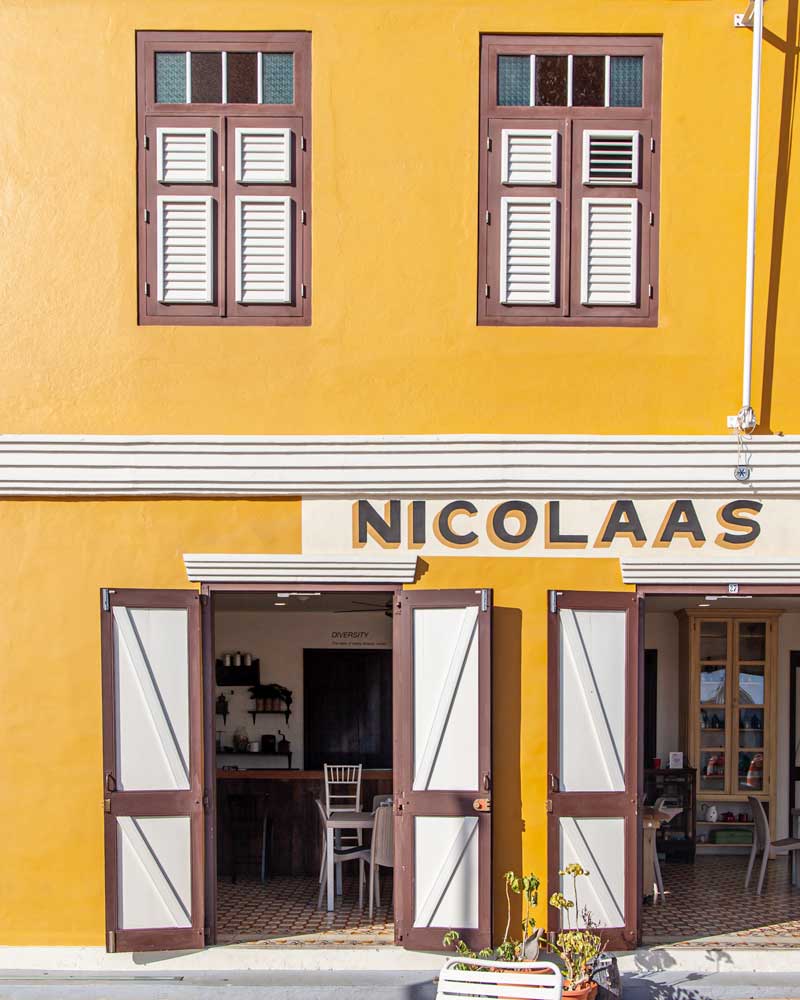
Street Art Walks
One of the best ways to get to know the city is through a street walk with one of the tour leaders from Cosecha. Once-run down walls have been smoothed over and now proudly display work from local artists, other Caribbean contributions, and, in-fact, street art from as far afield as Portugal.
In fact, two of my favourite artists from my adopted homeland were even there during my visit, and if you spot the ‘One Happy Island’ mural to the left of the centre, a little bit of my (terrible) spray-paint work is included!
The walk takes around 90 minutes and is almost reason enough to visit Aruba . It not only shows you some of the more hidden away pieces of art but also explains the stories, history and heritage behind them and the island. It’s not just a ‘this is a carnival dancer mural made of tiles’ kind of tour, but gives you back information on carnival itself, and the who, what, where of San Nicolas and the island as a whole.
Aruba Art Fair
Launched in 2016, the Aruba Art Fair brings even more creativity to the streets of San Nicolas.
Here, you’ll have the chance to see an extended range of arts, paintings, sculptures and prints throughout the city, and now the event attracts thousands of people over the three-day run.
Expect much more than just goods to buy, though, with performances, talks, tours and workshops for all ages to enjoy, alongside the chance to support local emerging artists who are prominently promoted during the fair.
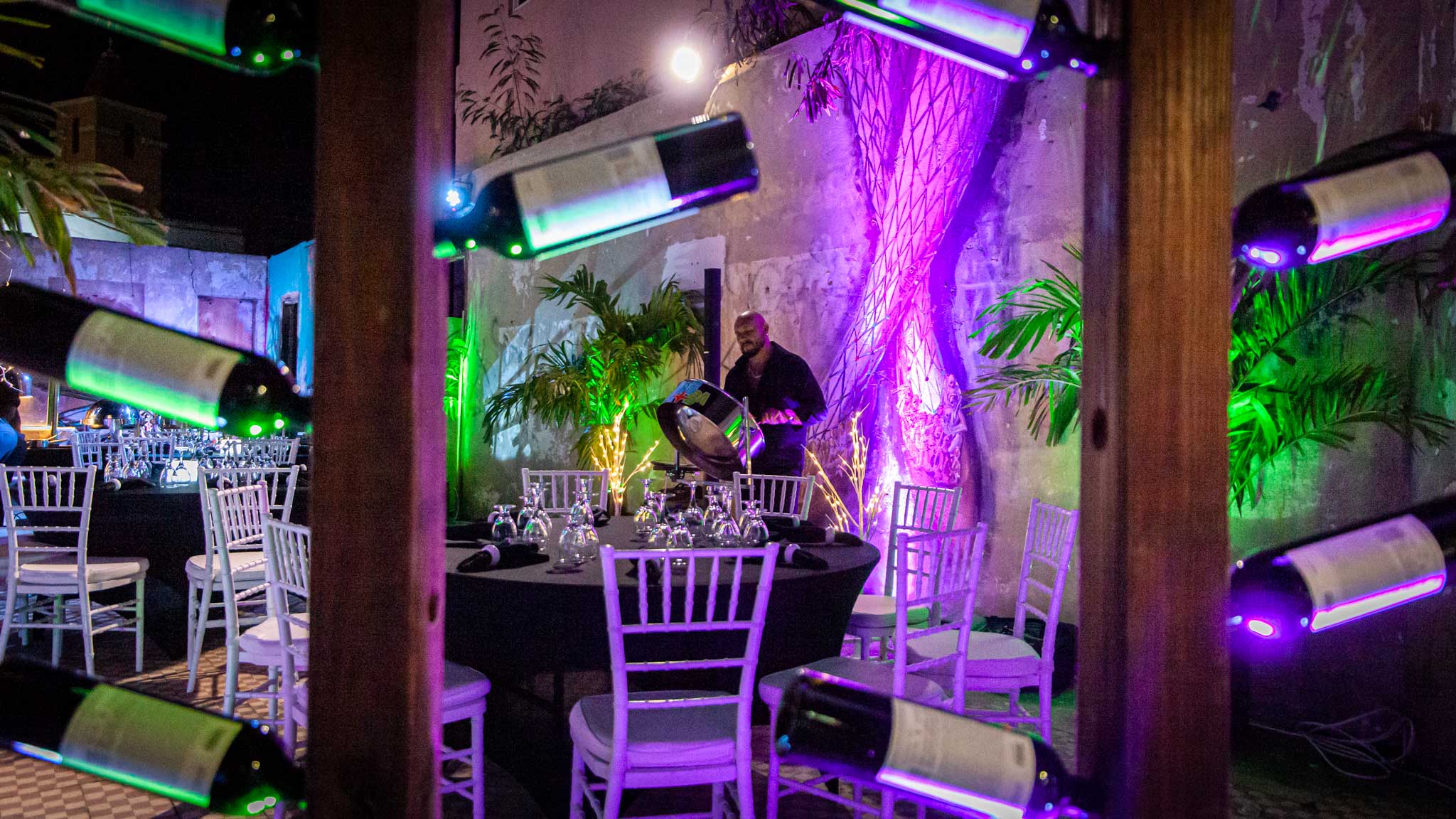
Carnival Museum
San Nicolas is also home to the newly built carnival museum , paying homage to this colourful and electric festival, which occurs early in the year.
This relatively recent addition to San Nicolas opened to the public in late 2019 and shares the history of Aruba Carnival alongside some truly fabulous and flamboyant outfits on the dressed-up mannequins.
You won’t need too long here, but after a short visit, there will be no doubt in your mind how important these celebrations are for Arubans, a great starting point on the route into San Nicolas before getting into a creative activity of your own.
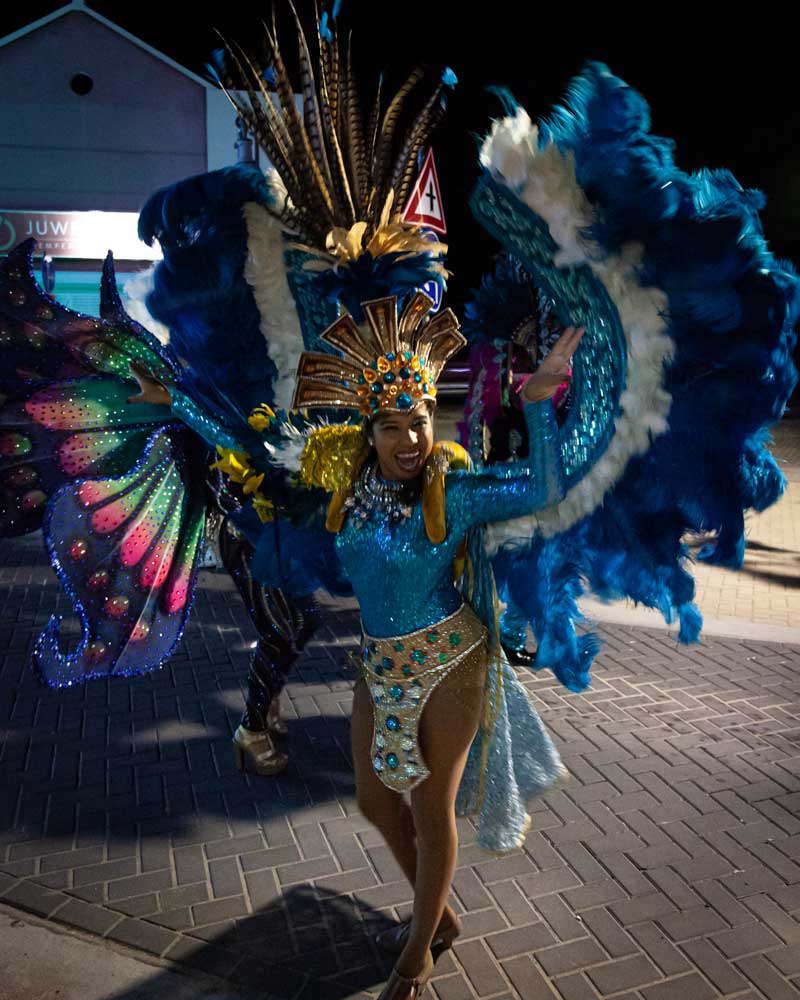
Pop-up Carnival Events
If you time your visit right, steel pans will echo across the streets as jewel-studded and feather-fitted outfits dance around you in a whirlwind of colour.
If I’m honest, I think it was this bite-size sampling of the carnival celebration that really stamped San Nicolas into my heart.
Most Thursdays (check with Cosecha in advance), you can sample the flavours of the festival here in the Sunrise City, with music, a mini carnival dance, and handicrafts that bring the streets alive.
From sundown, music blares out, people spill into the streets, and as guests, you are actively invited to join in the dance parade, and trust me, regardless of how you feel you’ll look, it will be good for the soul.
In addition, sometimes outside spaces are converted into pop-up carnival-style restaurants, with local bands playing as a buffet of delicious Aruban dishes is laid out, and groups of people mingle amongst what could have looked like bland roof-free buildings in the day but become a whole other playground during the evening illuminated by a kaleidoscope of colours.
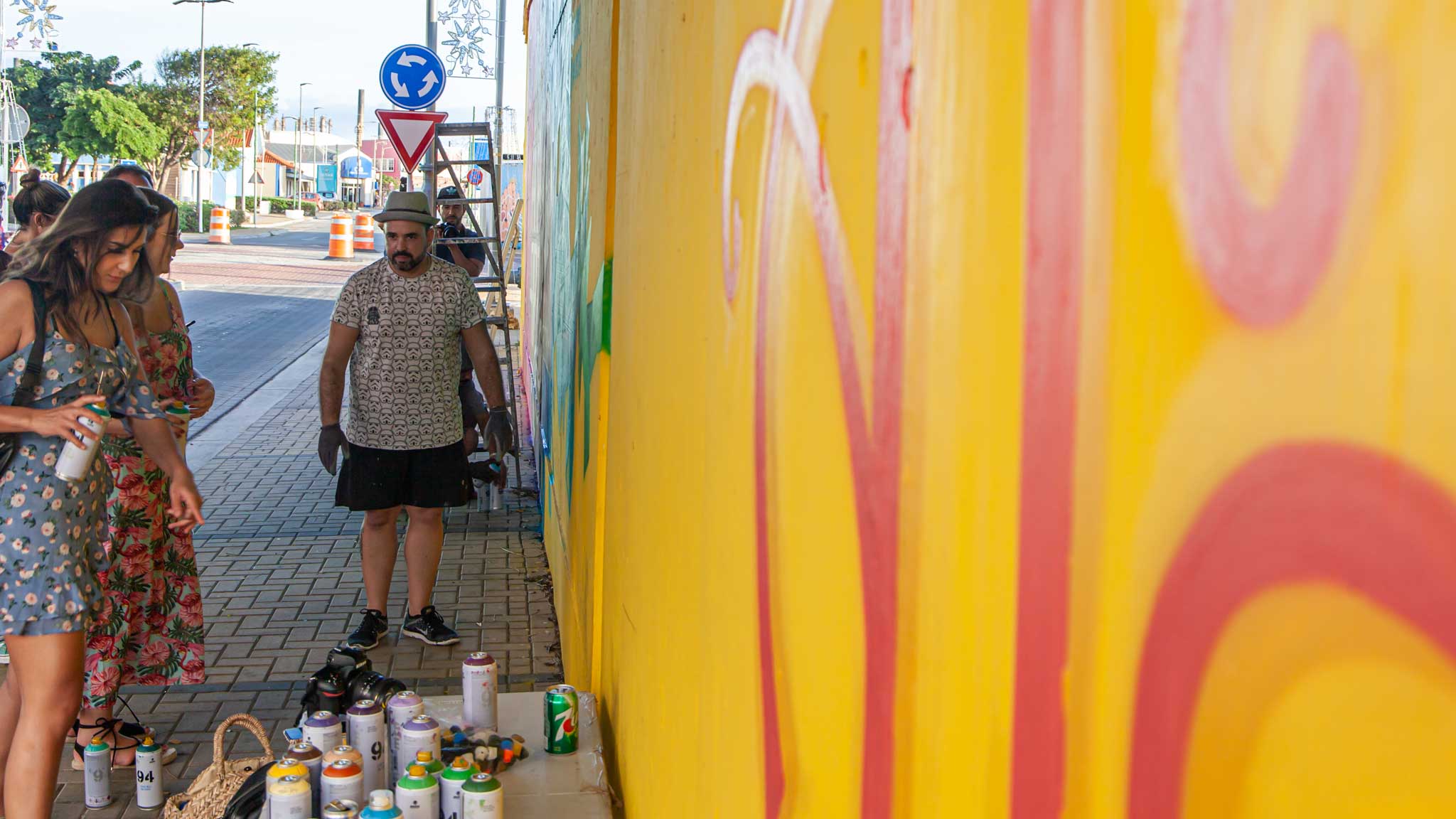
Carnival Celebrations
One of the best reasons to visit Aruba, and certainly San Nicolas, is during January and February when the colourful spirit of the island truly comes alive for Aruba Carnival .
The nation’s month-long celebrations culminate in an eye-popping celebration of colour, music, laughter, and dance, but the events leading up to it and throughout the month provide plenty of opportunities to join in.
With San Nicolas holding many titles – the second city, the sunrise city, the creative capital of Aruba – it’s no surprise it’s a worthy destination to spend some of the carnival celebrations at. Regardless of the time of year you visit, though, be sure to slip on down to San Nicolas, admire the passionate work of so many locals, and share in the joy of their hometown.
Inspired by a visit to Aruba? Get planning with my One Week in Aruba Travel Guide, or discover more of the most beautiful islands in the world .
Related Posts:
- Active or All-inclusive Caribbean? 5 Destinations for Every Kind of Traveller
- Luxury Island Face-Off: Maldives vs Mauritius, Aruba vs Antigua... or…
- Why Visit Aruba? 12 Reasons To Love The ‘One Happy Island'
- Things To Do in Dominica: Travel Guide & Trip Planning
- 10 Fantastic Ecotourism Destinations To Visit in 2024
- 25 Best Islands To Visit for a Unique Escape
I really love sunrise and your blog just lifted my spirit. The pictures you captured were all amazing. Thank you for sharing this and for letting us experience the culture and beauty of other country. @Enzo
Thanks Enzo :)
Leave a Reply
Leave a reply cancel reply.
Your email address will not be published. Required fields are marked *

Hey, I’m Dan…
Sign up for (irregular) updates.
Email Address *
Recent Articles…
- 12 Fantastic Things To Do in the UK
- 11 Unforgettable Things To Do in France
- 8 Alternative Spa and Wellness Destinations in Europe
- 9 Blissful Beach Destinations for Sun, Sand, and Serenity
- A Guide to Gijón, Spain: Asturias’ Beloved Beach Escape
- Summer Highs in Innsbruck, Where the Alps Are for All
- A Quick Guide To The 11 Major Edinburgh Festivals in 2024
- 8 Remote and Secluded Places to Travel for an Isolated Escape


IMAGES
VIDEO
COMMENTS
San Clemente Island as well as San Nicholas Island have been absconded by the federal government, and I don't like it. There is no reason for an early warning aircraft alert off shore in this day and age. Really, two of the best islands we have offshore. Can't walk on them, fish unless given permission or camp out and enjoy the island solitude.
The island has its own small airport, so if you don't know how to get to San Nicolas Island, flying is ideal. San Nicolas Island is a destination that is well worth the effort to visit. Whether you're a nature lover, a history buff, or just looking for a unique and off-the-beaten-path destination, San Nicolas Island is a gem that is waiting ...
Diving. Channel Islands Expeditions travels out to San Nicolas Island during the summer and early fall to dive the iconic Begg Rock and some of the island's nearshore reefs. Begg Rock is a small rock lying almost 8 miles to the west from the island and it is one of California's most pristine dive locations. This is open ocean diving so wind ...
Alone on an island for 18 years. Island of the Blue Dolphins is a work of historical fiction based on the life of an American Indian woman who spent 18 years in isolation on San Nicolas Island, one of eight Channel Islands off the coast of Southern California.. In the book she's named Karana. Her birth name is lost to history, but she's often referred to as the Lone Woman of San Nicolas Island ...
San Nicolas Island. San Nicolas Island. Quick Facts. Size: 58.93 sq. miles. Distance from mainland: 61 miles. Did You Know? The US Navy owns San Nicolas Island. It is a naval weapons testing and training facility. In the past it has served as launch site for military research rockets.
Though Karana's home on San Nicolas Island is a creation of Island of the Blue Dolphins author Scott O'Dell, many of the animals, plants, people, and places are based on the actual Channel Islands, which you can explore and learn more about on this website.. Once you've journeyed through this web resource's features, you can visit the Channel Islands National Park website.
As of the latest census in 2023, the island is home to approximately XXXX residents. However, don't be fooled by the island's small size - it's the people that truly make it special. The Santa Cruz Connection. San Nicolas Island may be best known for its association with the legendary character, the "Lone Woman of San Nicolas Island."
Visit Adventures. Trips Highlight. South Africa ... From 1835 to 1853, a Native American woman, stranded after the evacuation of her people, lived alone on San Nicolas Island. Her story inspired ...
Island Conservation San Nicolas Island, California - Island Conservation. San Nicolas Island (14,569 acres) is located sixty-one miles due west of Los Angeles and is the most remote of the eight islands in the Channel Island archipelago. The island is owned and managed by the US Navy. The island is the setting for Scott O'Dell's prize ...
Map of Channel Islands. San Nicolas Island (Spanish: Isla de San Nicolás; Tongva: Haraasnga) is the most remote of the Channel Islands, off of Southern California, 61 miles (98 km) from the nearest point on the mainland coast.It is part of Ventura County.The 14,562 acre (58.93 km 2 or 22.753 sq mi) island is currently controlled by the United States Navy and is used as a weapons testing and ...
Island of the Blue Dolphins is a work of historical fiction based on the life of an American Indian woman who lived 18 years in relative isolation on San Nicolas Island. Scott O'Dell conducted extensive research before writing the novel in order to assure as much historical accuracy as possible. Many of the book's facts and details ...
In collaboration with the Navy Marine Ecology Consortium (NMEC), our Natural Resource team returned to the island to explore and study the unique and inspiring intertidal ecosystems protected at San Nicolas. Taking on four different sites around the island, Navy and Park biologists documented health assessments on critical habitat and species.
About San Nicolas Island . San Nicolas Island is the most remote of California's Channel Islands, located 61 miles from the nearest point on the mainland coast. It is part of Ventura County. ... We also learned the reason for the BBQ tongs in the toolbox - they make planting a cactus a cinch. n 4 1/2 days, and together with CIR's Kevin, Kelle ...
San Nicolas Island Restoration Project, California San Nicolas Island This 14,569-acre island, located 61 miles due west of Los Angeles, is the most remote of the eight islands in the Channel Island Archipelago. The island is owned and managed by the U.S. Navy. The island is the setting for Scott O'Dell's prize-winning 1960 novel, Island of the
As the most remote of the California Channel Islands, San Nicolas has the reputation of being a mysterious, wind-swept place. Known popularly as the Island of the Blue Dolphins from the 1960 Scott O'Dell novel, this place served as the setting for the tale, which was inspired by the real-life events of the Lone Woman.
San Nicolas Island is the king of isolation, a 22.73 square mile touch of grey on the edge of the North Pacific, the most remote of the Channel Islands. Operated by the Navy and part of the Pacific Missile Range, San Nic is a weapons testing and training facility with an airstrip and a cluster of buildings. The indigenous tribe living on the ...
The walking tours are on Tuesday and Thursday at 10:30 and 14:30. In addition, this Visitor Information Center can be the perfect departure point to discover San Nicolas City on foot as it is located in the main street of the city. Please let the staff inform you of everything the main street and the region has to offer, you will be surprised.
2.7K shares. With a thriving arts scene, laid-back vibe and prime location near breathtaking beaches, the colourful town of San Nicolas is one of the best places to visit in Aruba to get a dose of culture. Far removed from the glitz, glam and commercialization of tourist areas like Palm Beach and the capital Oranjestad, the so-called 'Sunrise ...
San Nicolas Island is the most remote of California's Channel Islands lying 78 nautical miles (nm) south by southeast from Santa Barbara and 53 miles from the nearest coastline. Rising out of the rolling Pacific swells, the 14,500 acre (23 square miles) island is defined by wave cut terraces and windswept, grassy hills.
For history buffs, a visit to the San Nicolas Community Museum is a must. Housed in a former police station, the museum showcases the town's history, including its industrial past and the cultural heritage of its people. ... Reasons To Visit Aruba, The Happy Island Escape We All Need. Cruises . Everything You Need To Know About The Carnival ...
Although San Nicolas, Aruba's 'Sunrise City', is a quiet coastal town of 32.84 km2 located only twelve miles southeast of Oranjestad, it seems a world away. In the heart of Aruba's second largest city is a quaint promenade on Zeppenfeldstraat, an art murals, some shops, snack shops, restaurants and bars as well as historic buildings of ...
One of the best reasons to visit Aruba, and certainly San Nicolas, is during January and February when the colourful spirit of the island truly comes alive for Aruba Carnival. The nation's month-long celebrations culminate in an eye-popping celebration of colour, music, laughter, and dance, but the events leading up to it and throughout the ...